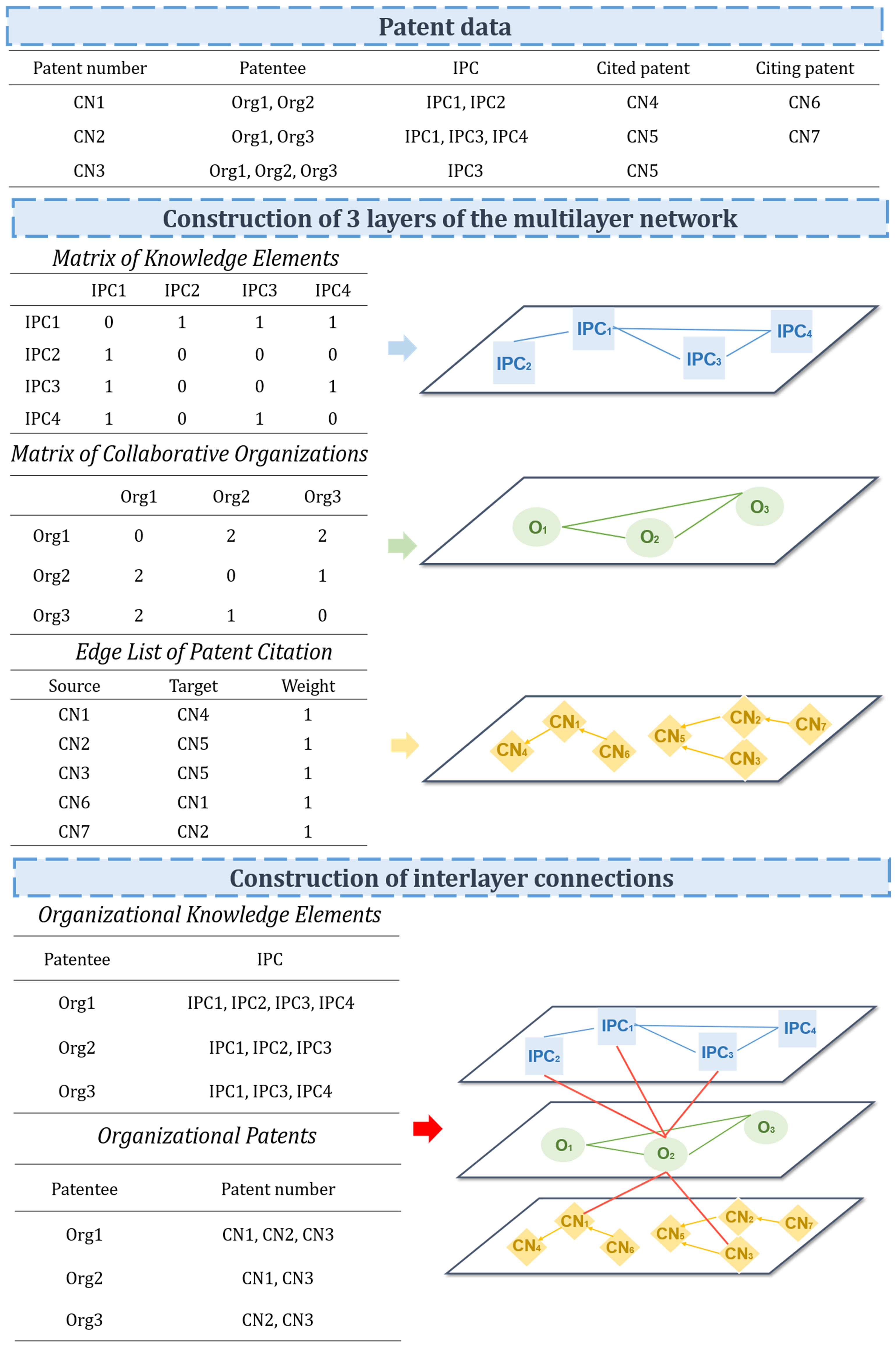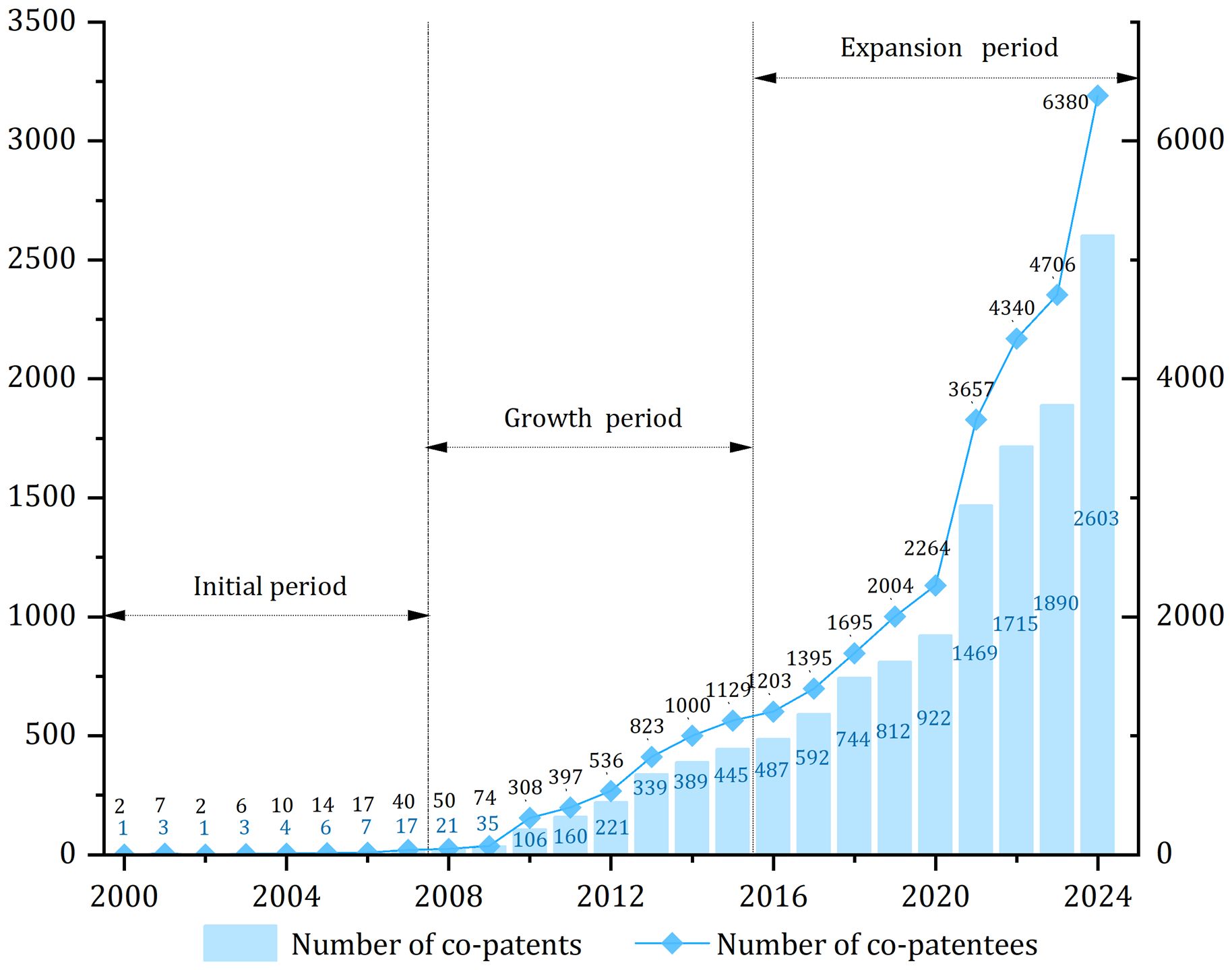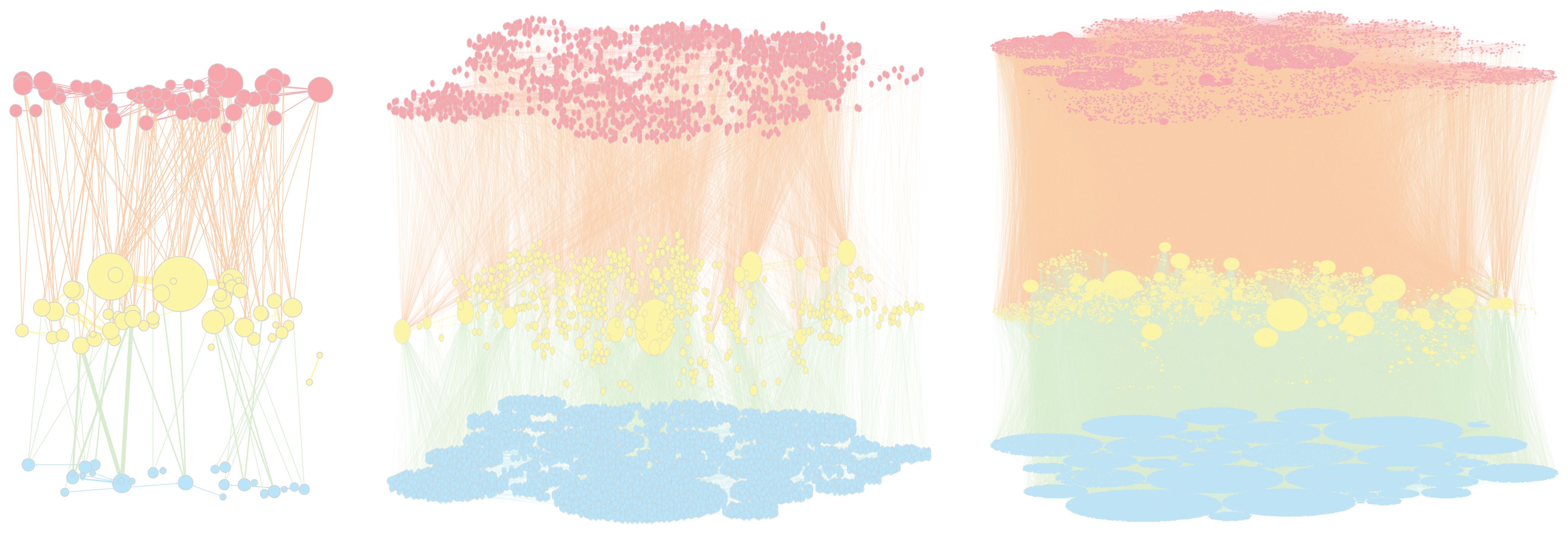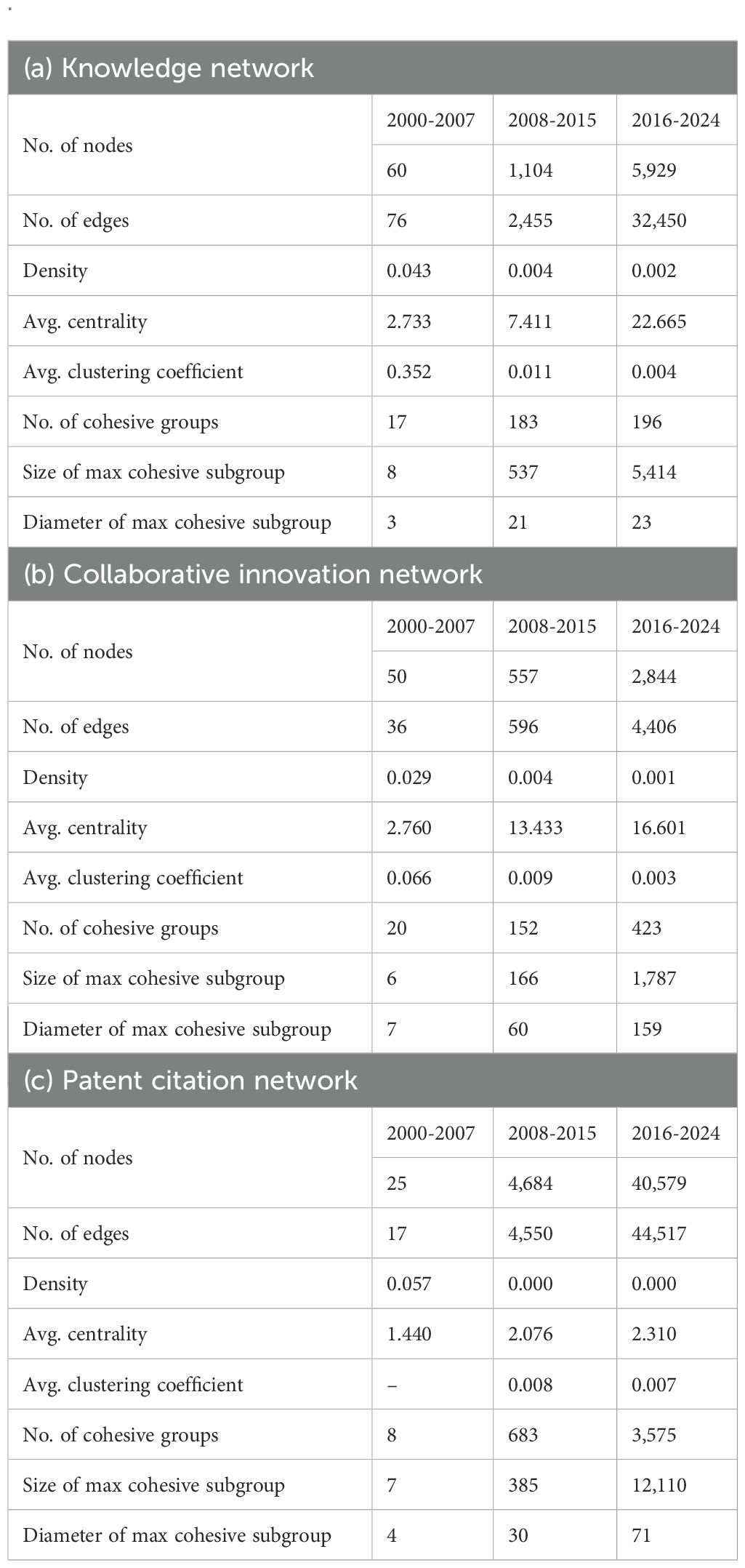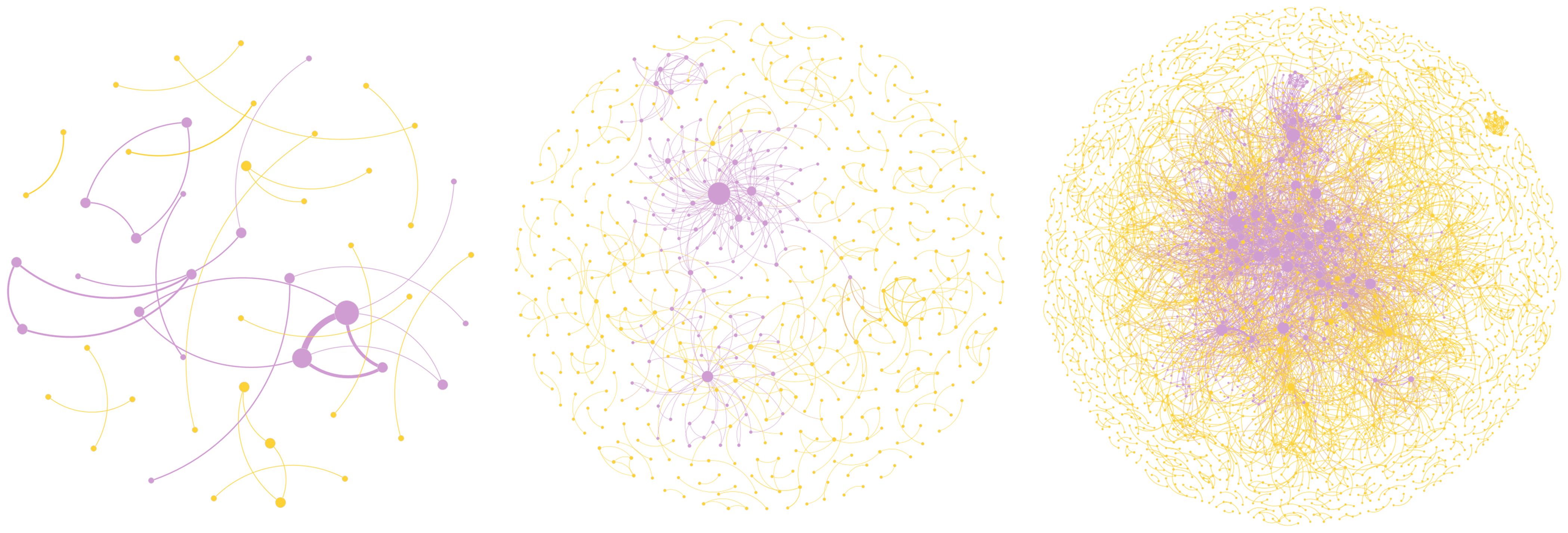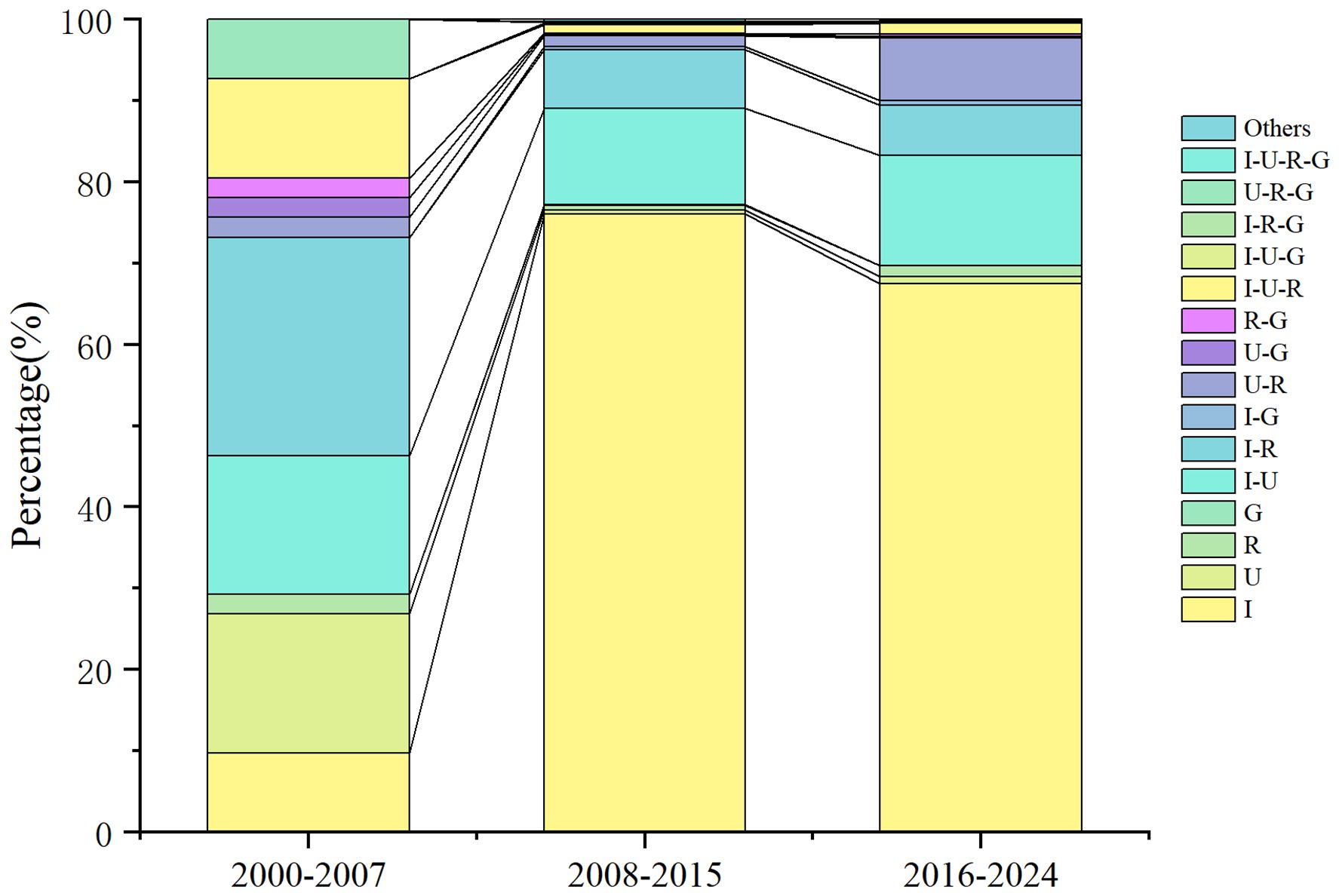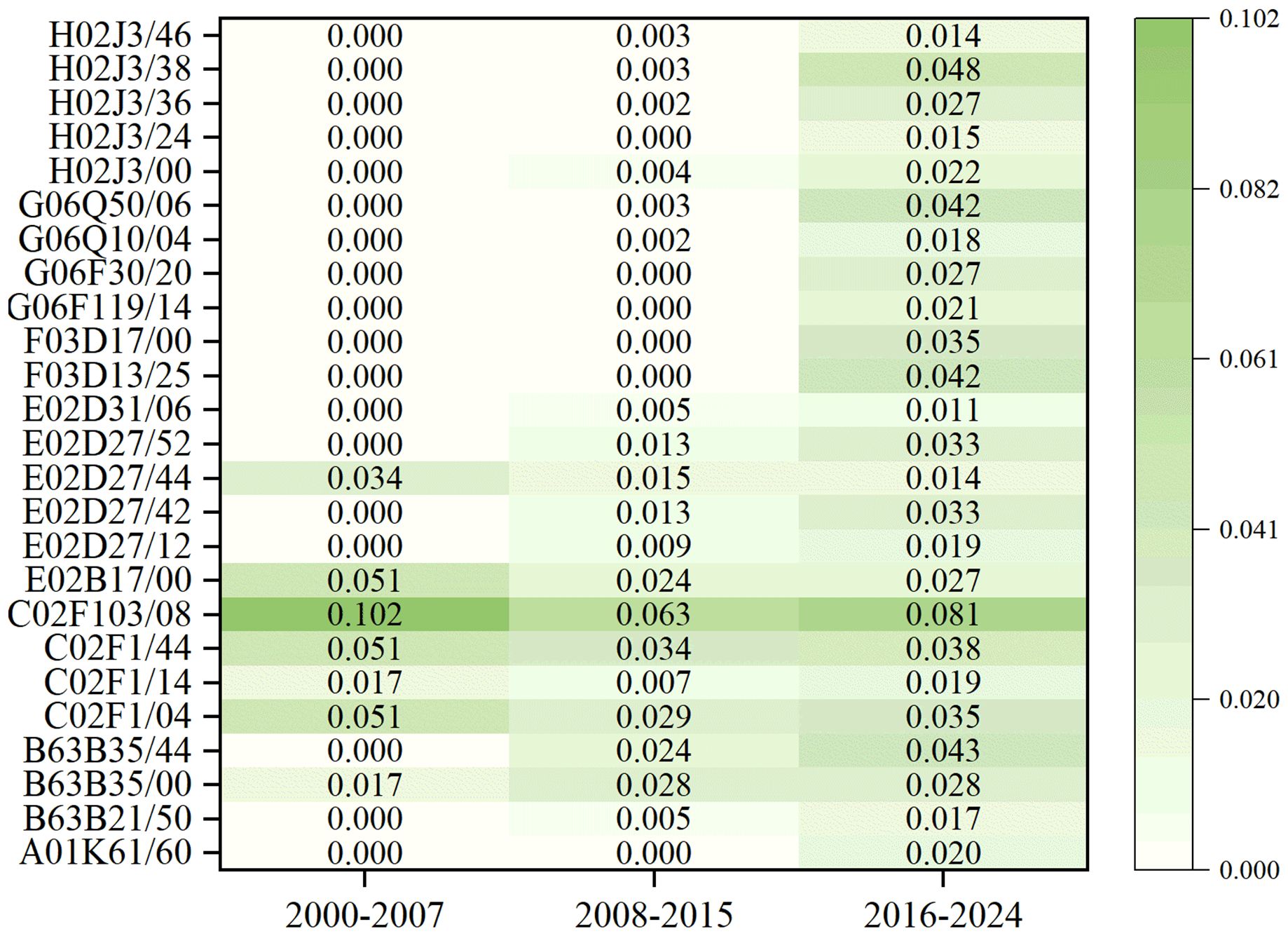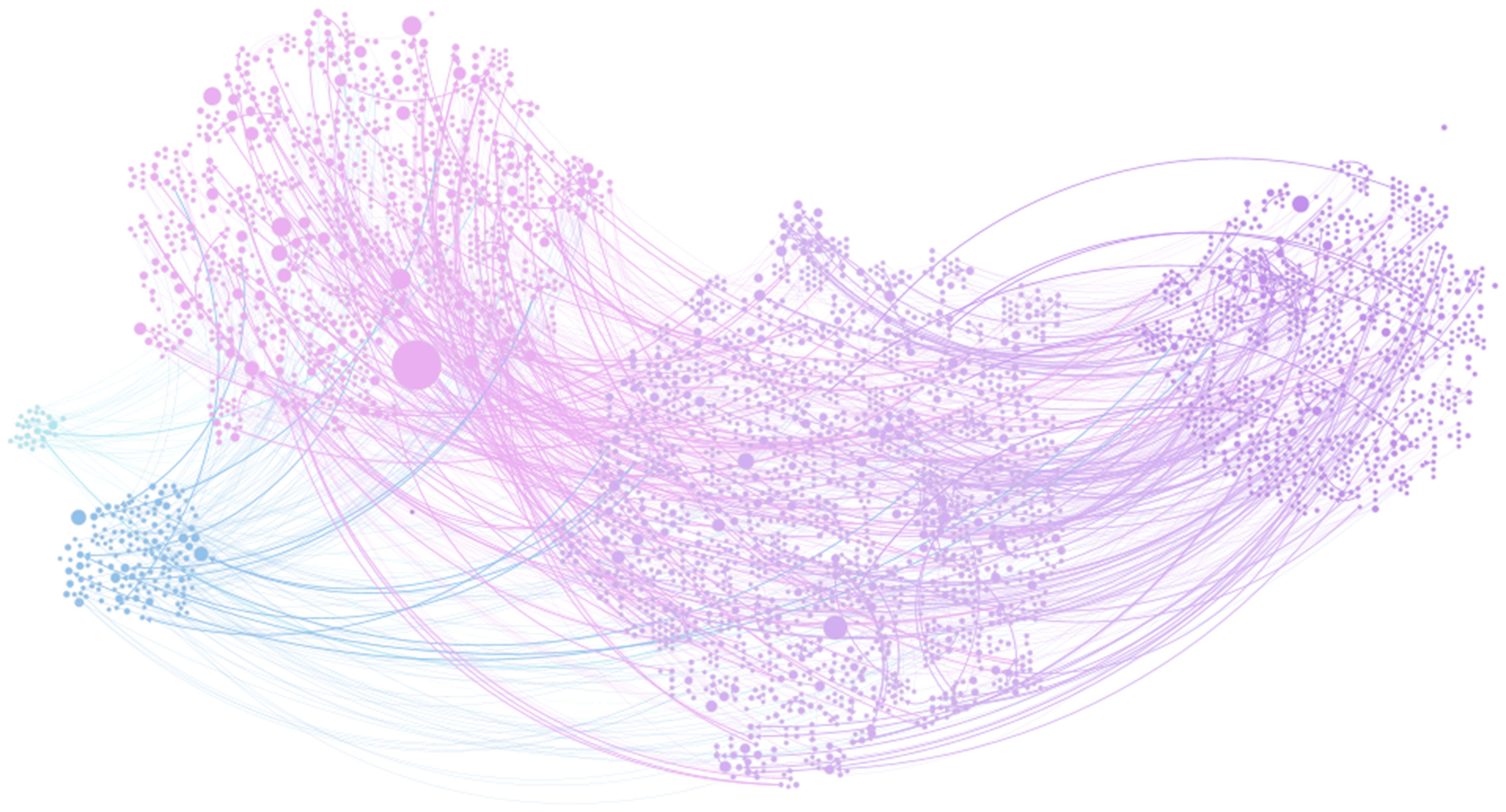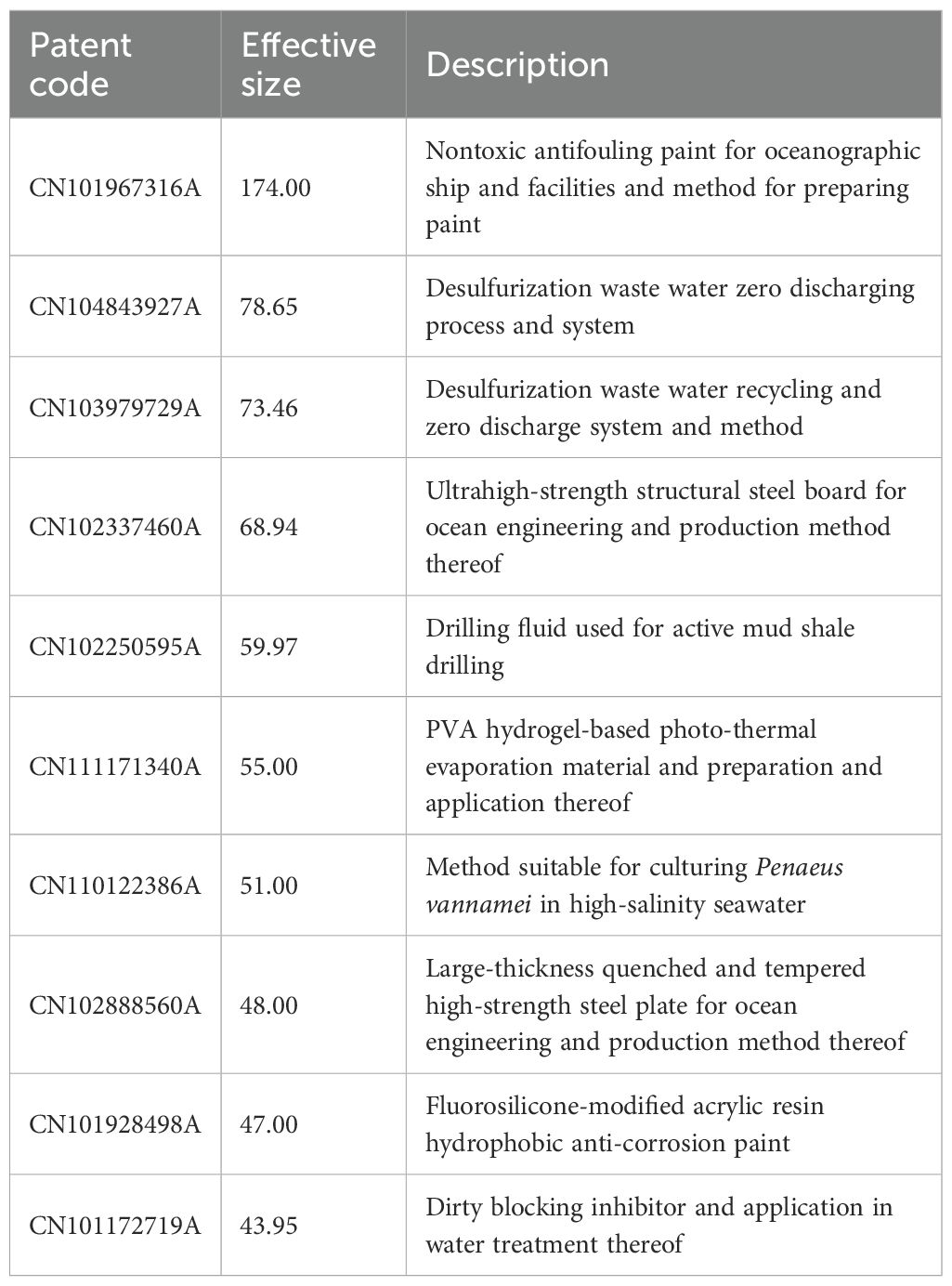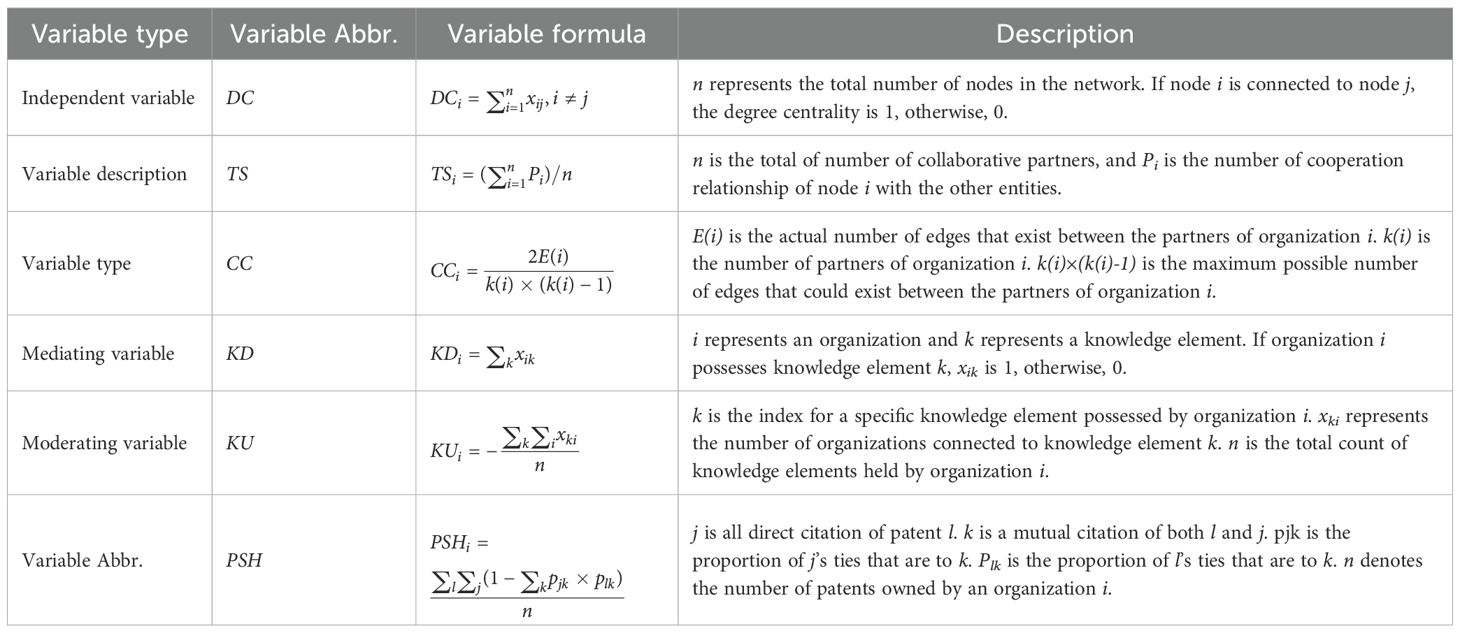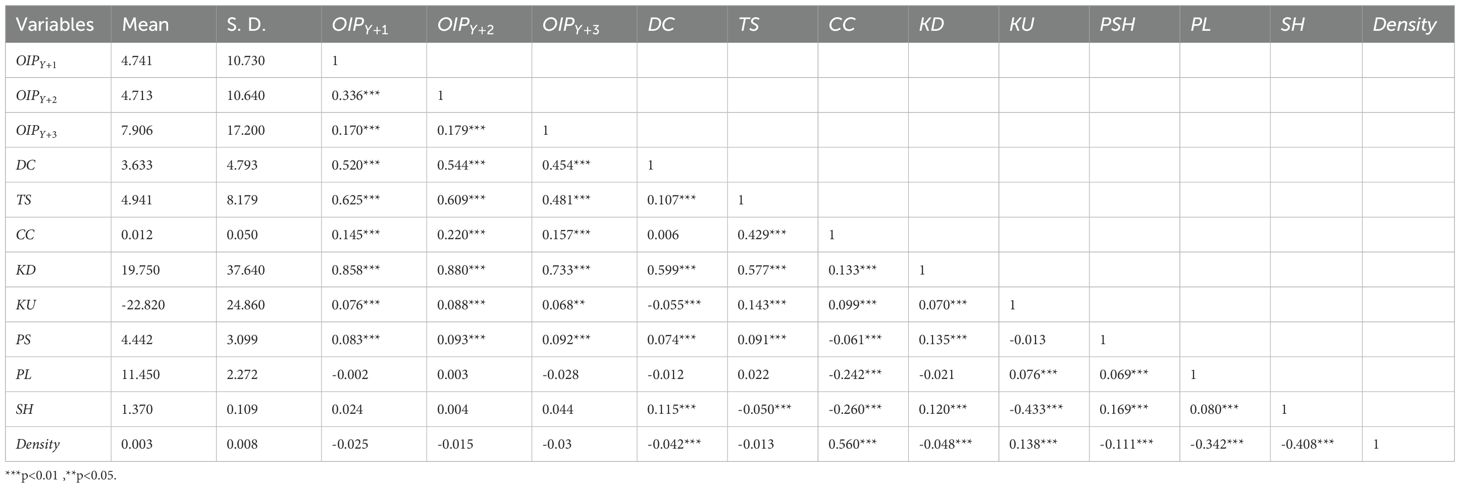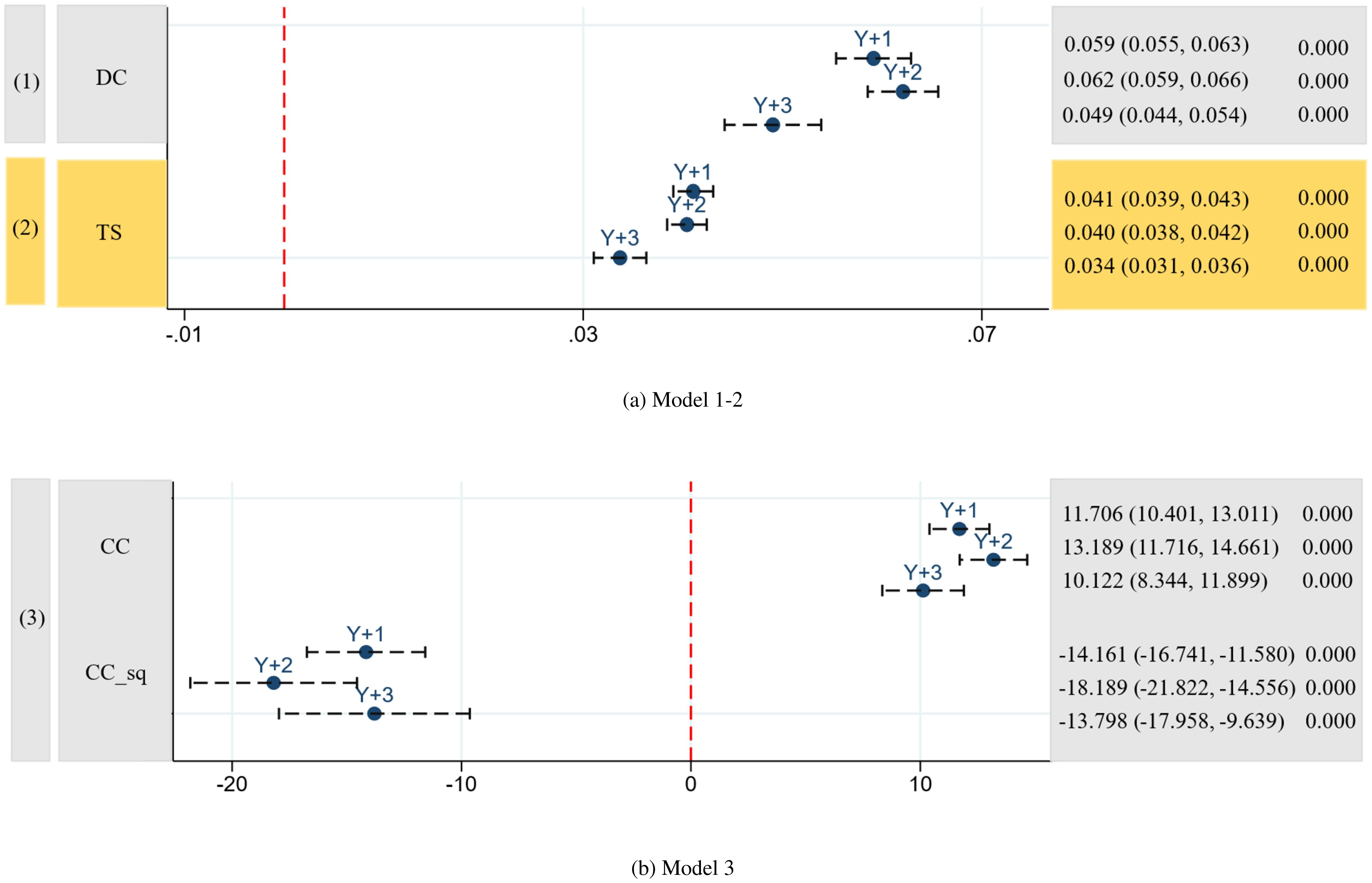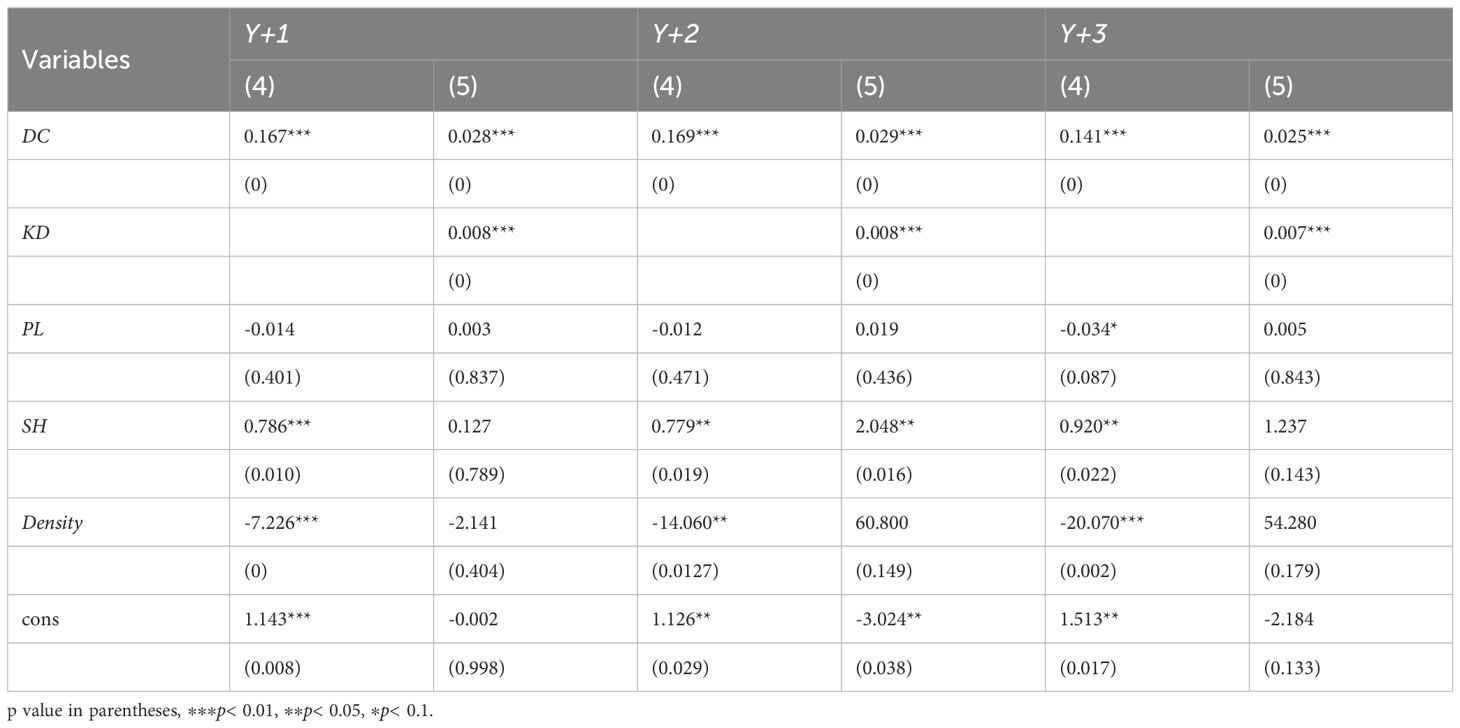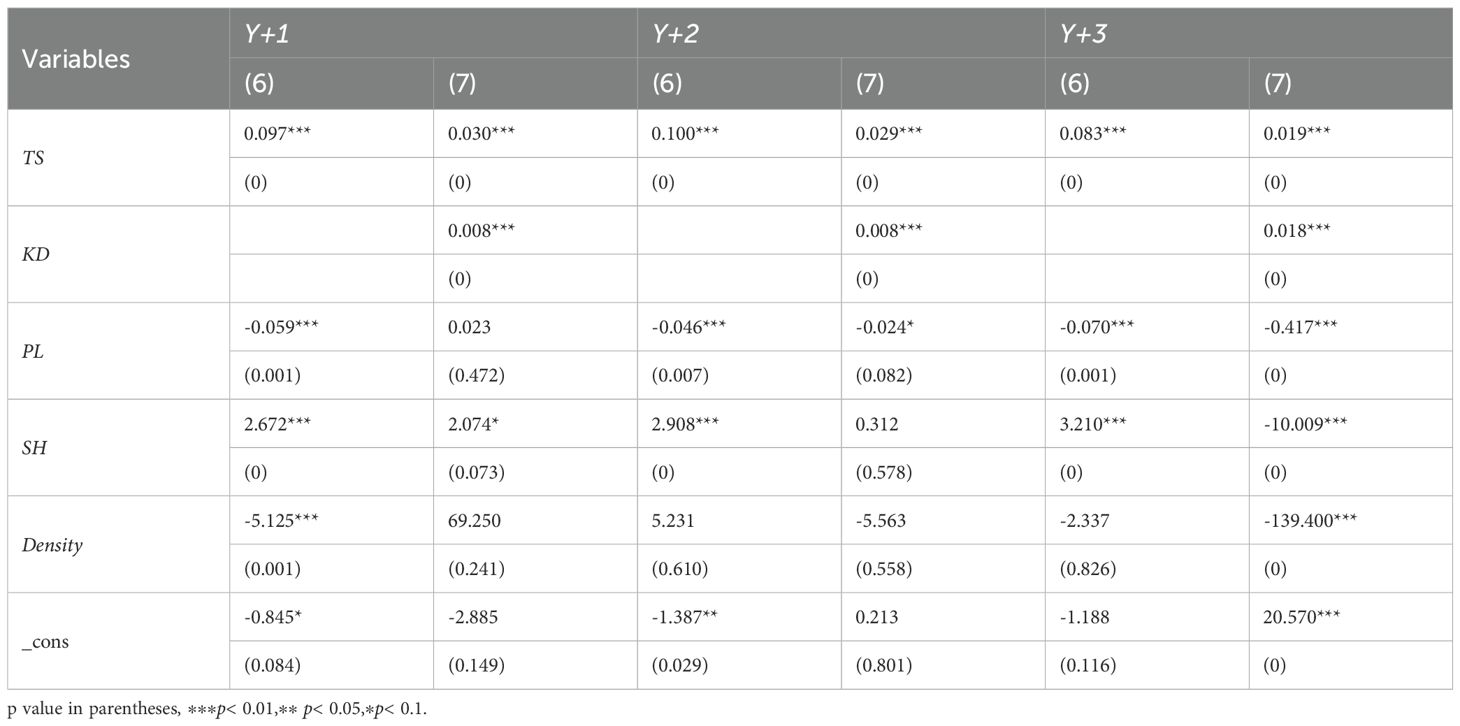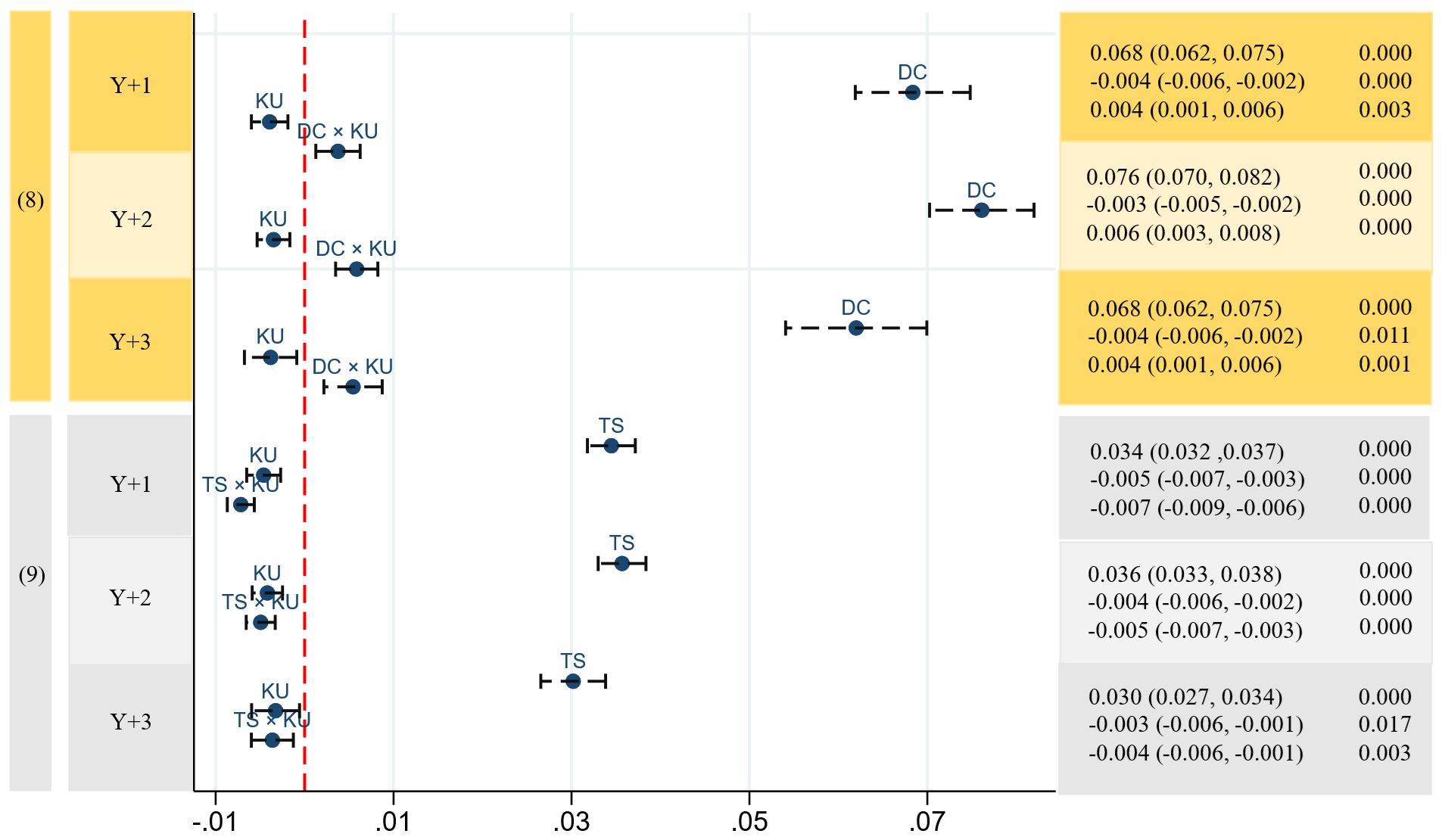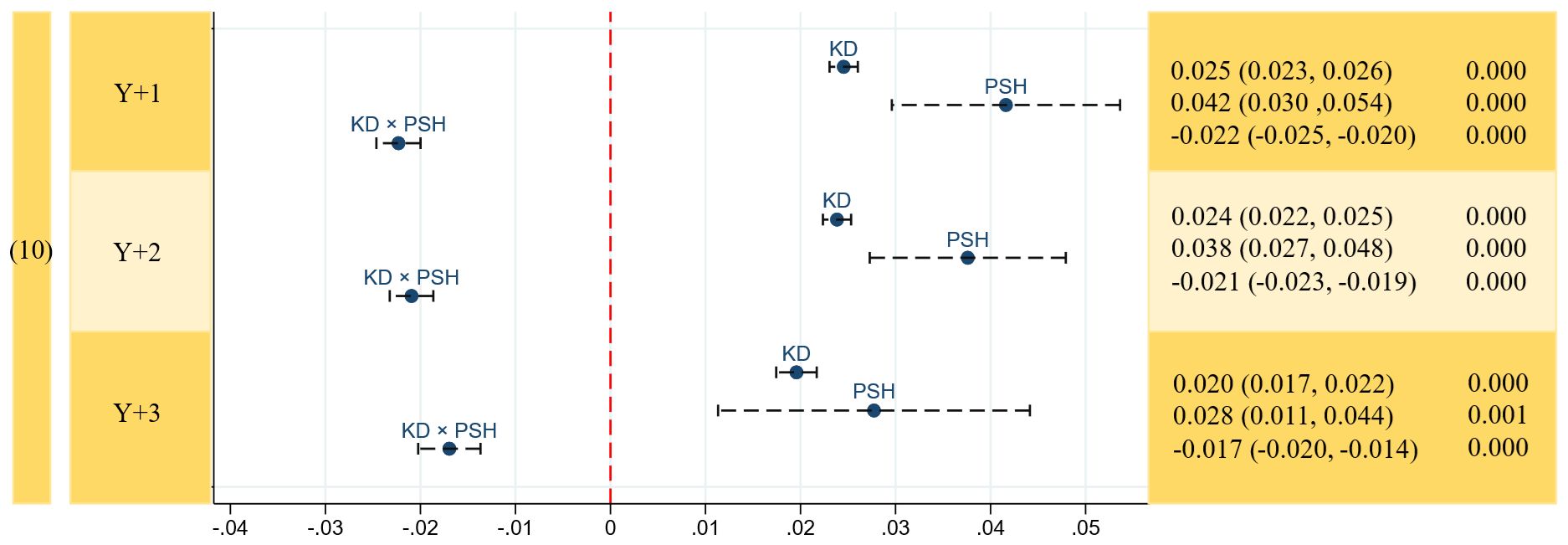- 1School of Management, Guangdong Ocean University, Zhanjiang, China
- 2College of Economics and Management, Shanghai Ocean University, Shanghai, China
- 3School of Economics, Guangdong Ocean University, Zhanjiang, China
- 4Southern Marine Science and Engineering Guangdong Laboratory (Zhanjiang), Zhanjiang, China
Fostering a dynamic innovation ecosystem is a key strategic challenge for China’s marine industry, yet organizations and policymakers lack a clear understanding of what types of collaborative structures truly drive performance. This study moves beyond traditional single-layer analyses to construct a comprehensive multilayer network of inter-organizational collaboration, knowledge flows, and technological evolution, using patent data from 2000 to 2024. The research analyzes the structural characteristics and evolution trend of the multilayer network to reveal the longitudinal dynamics of the China’s marine industry’s collaborative innovation landscape. A negative binomial regression is used to examine the effect of network characteristics on organizational innovation performance. Findings reveal that while both broad and deep partnerships significantly boost innovation, this effect is mediated by knowledge diversity. The positive impact is contingent on the organizational knowledge assets. Organizations with unique knowledge gain more from broad, shallow ties, compared to deep and intensive collaborations. For highly knowledgeable organizations, occupying too many strategic network positions can lead to information overload and diminishing innovation performance. This research provides an evidence-based framework for managers to optimize their R&D collaboration strategies and for policymakers to design more effective innovation policies, ensuring a more robust and dynamic marine innovation ecosystem.
1 Introduction
As global economic development confronts challenges of land resource scarcity and the contraction of traditional growth avenues, the ocean, with its vast resource potential and commercial value, is emerging as a key engine for economic growth (Wang and Sheng, 2021; Xie and Li, 2024). China has elevated marine economy development to strategic importance. In 2024, China’s gross ocean product (GOP) reached 10.54 trillion yuan, accounting for 5.9 percentage of the national gross domestic product, highlighting the significant vitality of the marine economy as a new growth driver. China’s 2025 government work report designates deep-sea technology as a key strategic emerging industry. Furthermore, the sixth meeting of the central financial and economic affairs commission in 2025 explicitly called for “enhancing the independent innovation capability of marine science and technology, and expanding marine industries,” establishing technological innovation as the core pathway to become a maritime power.
Extensive research shows that innovation significantly drives the upgrading of industrial structures and economic growth within marine economy and industry (Zeyringer et al., 2018; Yu and Zou, 2020; Ren and Ji, 2021; Shao et al., 2021). Compared to purely material capital investment, intellectual support centered on science and technology is increasingly imperative to the future growth of the marine industry (Shao et al., 2021). As the marine industry is a comprehensive system involving 15 sub-sectors and intricate value chains, its innovation activities are inherently cross-organizational and interdisciplinary (Ding and Zhang, 2022). Consequently, it is difficult for any single entity to undertake complex innovation tasks independently. Building collaborative innovation networks to integrate technological resources across organizational boundaries, coordinate on key challenges, and accelerate the commercialization of research outcomes has become an essential routine for cultivating innovation capabilities in China’s marine industry.
Given the inherent complexities of China’s marine industry, academics are actively exploring its innovation landscape. Research on innovation of marine industry can be classified into three categories. The first stream of research focuses on the measurement and evaluation of marine industry’s innovation efficiency (Li et al., 2021; Sheng et al., 2021; Zhang and Wang, 2021; Fu et al., 2022; Li et al., 2025). For example, (Li et al., 2021) employed stochastic frontier analysis to quantify the efficiency of marine innovation in China, subsequently dissecting its regional disparities and influencing factors. On the other hand, a growing stream of research examines marine industry innovation through the lens of an open and complex system. Xu et al. (2024) quantified the synergistic relationship among China’s marine economy, innovation, and ecology. Wan et al. (2023) proposed a tripartite collaborative innovation system by analyzing the coordination of relationships, resource sharing, and cooperative activities. Building on the network perspective, Ma and Hou (2024) further detailed the innovation process by establishing a technological innovation chain that links enterprises with academic and financial institutions. The third category of studies focus on the innovation dynamics within China’s marine industry and the role of its networks within specific sectors of the marine industry (Zhang et al., 2019; Fu et al., 2023) or particular regions (Wang et al., 2016). Utilizing social network analysis, Zhang et al. (2019) established an industry-university-research network grounded in collaborative patents within the marine biomedical industry, demonstrating that greater collaborative breadth and depth enhance innovation performance. Additionally, Fu et al. (2023) revealed that increased local clustering within collaborative networks positively impacts the innovative output of the marine biomedical industry.
While existing research has progressively deepened in granularity, expanding its scope from macro-level measurement of innovation efficiency to the exploration of evolutionary mechanisms of marine industrial innovation from a complex systems perspective, and further delving into the structural characteristics of innovation networks at the organizational level, the extant literature still presents several limitations and research gaps.
First, existing studies often fail to comprehensively capture the interdisciplinary and holistic nature of China’s marine industry. Their investigative scope is frequently confined to specific sub-sectors, such as the marine biomedical (Zhang et al., 2019; Fu et al., 2023) or new materials industries (Cui et al., 2025), or limited to provincial regions (Wang et al., 2016). Given the current trend of increasing cross-industry and inter-regional cooperation, an analysis of the innovation development pathways and evolutionary patterns of China’s marine industry from a systematic perspective is urgently required.
Second, the influence of knowledge resources on innovation collaboration within the marine industry has yet to be thoroughly examined. Breakthroughs in strategic emerging marine industries, which are poised to become pillar industries for China’s future marine economy, are more critically dependent on unique and inimitable knowledge resources compared to traditional marine industries. Investigating the role of knowledge resources in collaborative innovation can provide deeper insights into the intrinsic mechanisms driving organizational innovation.
Third, despite the high growth potential, strategic emerging marine industries face critical bottlenecks in core technological areas, leaving them vulnerable to external constraints (Yin et al., 2024). The trajectory of technological evolution in these industries is pivotal in determining their competitive standing within global industrial and value chains. Therefore, exploring the technological evolution paths of China’s marine industry can identify essential technologies needed for current industrial development, clarify the core directions for innovation cooperation, and avert the misallocation of innovation resources.
Furthermore, the mechanisms that how topological features of the innovative networks impact the innovation performance of organizations in China’s marine industry remain critical yet underexplored questions. Current studies concerning China’s marine industry have predominantly focused on the role of organizational collaboration networks in enhancing innovation performance, primarily by facilitating inter-organizational information exchange (Guo et al., 2023; Fu et al., 2023; Zhang et al., 2019). However, such a singular-level network analysis overlooks crucial dimensions of knowledge flow and technological lineage that are fundamentally intertwined in both innovation processes and organizational collaboration, and which collectively determine the success of technological innovation.
Indeed, knowledge resources are the indispensable underpinning of innovation. Innovation can be conceptualized as a process of combining or recombining existing knowledge elements (Fleming, 2001). Collective innovation, therefore, is embedded not only within social networks but also within knowledge networks. An organization’s knowledge base can be viewed as a network formed by the coupling relationships among its knowledge elements. These relationships signify the historical associations between knowledge elements during past innovation processes, thereby guiding potential future recombination of knowledge (Yayavaram and Ahuja, 2008; Wang et al., 2014; Yan and Guan, 2018; Sui et al., 2025).Patents serve as externalized manifestations of innovative outcomes. Patent citations, in particular, represent the spillover effects of an organization’s explicit knowledge. While citations are used to measure the inflow of knowledge from other technologies (Kim et al., 2014), the frequency with which a patent is cited is indicative of its inventive quality and technological importance (Yayavaram and Ahuja, 2008). Moreover, patent citations can reflect the inheritance and evolutionary path of technical knowledge (Wang et al., 2025b). It is crucial to note that organizations can acquire knowledge from others, and subsequently enhance their own innovation performance, through patent citation networks even when there is no direct collaborative link (no connection in social cooperation networks). This indirect knowledge transfer pathway is often obscured in analyses focusing solely on cooperation networks, leading to an incomplete explanation of the mechanisms influencing innovation performance. Therefore, understanding innovation as a complete process, from the recombination of an organization’s knowledge elements to cross-boundary collaboration between organizations, and finally to the output and recognition of innovation outcomes, is essential. This comprehensive view directly corresponds to the multilayered network approach adopted in this study, which integrates knowledge networks, cooperation networks, and patent citation networks.
Based on collaborative patent data of China’s marine industry from 2000 to 2024, this research integrates three distinct yet interrelated dimensions: knowledge combination, organizational collaboration, and technological flow, into a unified analytical framework and analyzes the dynamic evolution of the multilayer network of China’s marine industry. Leveraging social network analysis, we apply structural indicators to trace the network’s trajectory and visualize its shifting configurations across various stages, thereby revealing its complex collaborative dynamics over time. Subsequently, we aggregate the characteristics from the knowledge element layer and the patent citation layer to their corresponding organizations in the collaborative innovation layer. Building upon this structural analysis, the paper uses negative binomial regression to examine how an organization’s embeddedness of the multilayer network impacts its innovation performance of China’s marine industry. Particularly, this research investigates the following research questions.
1. What collaboration patterns are effective for improving innovation performance in the marine industry?
2. How can organizations strategically leverage their knowledge assets within the innovation network?
3. What are the hidden risks of certain network positions that organizations should be aware of?
The remainder of this paper is structured as follows. Section 2 details the research design. Section 3 analyzes the evolutionary and structural characteristics of the multilayer networks. Section 4 presents and discusses the empirical results. Finally, Section 5 concludes the paper with a summary of findings, implications, and directions for future research.
2 Research design
2.1 Patent analysis
In existing studies, two primary methodologies are commonly employed to measure innovation dynamics. One prominent method is patent analysis. The novelty and originality required for patent applications serve as a direct and objective manifestation of innovative outcomes (Ardito et al., 2018). A patent typically comprises technical embodiments, technology classification codes, citation information, and ownership details (Park et al., 2018). This detailed information about the invention and its background (Griliches, 1998) enables clear identification of technological fields, making patents widely used to analyze technological development trends and track dynamics within specific industries (Fontana et al., 2009; Ardito et al., 2018; Hu et al., 2024; Lee, 2024; Wang et al., 2025b). Scholars frequently utilize the information contained in patents to construct innovation networks, thereby analyzing their structures and the role of collaboration on innovation performance (Barbosa et al., 2024). The other primary measurement involves market-oriented indicators, such as the proportion of revenue from new products. This approach is valuable because not all inventions meet patentability requirements, and some companies opt for trade secret protection over patenting. Market-oriented indicators can cover a broader range of innovation outcomes and more directly reflect the economic value of new products.
Crucially, for the Chinese marine industry context, there is a significant lack of publicly available, granular data on organization-level market-oriented indicators such as new product revenue. Given this data constraint, and consistent with numerous previous studies (Guo et al., 2023; Fu et al., 2023; Zhang et al., 2019) that face similar challenges, our study adopts patent information to construct the multilayer networks.
2.2 Construction of multilayer networks
Social network analysis (SNA) is a powerful quantitative method employed to measure the relationships (ties) among different nodes, thereby enabling the interpretation of network structure and the attributes of constituent actors (Hanneman and Riddle, 2005). Given that many forms of data can naturally be formulated as network tasks, network analysis has garnered escalating research attention across various disciplines (Zhang and Lauw, 2021; Li et al., 2024; Chen et al., 2020a; Chen et al., 2020b). Innovative collaboration forms the fundamental nexus of sharing and connection among actors, which gradually evolves into a collaboration network (Jia et al., 2025). As innovative collaboration becomes increasingly complex and involves growing diversity of information, the analytical framework has necessarily been extended from single-layer networks to multilayer networks. Multilayer networks are particularly adept at accommodating both intra-layer and inter-layer information (Zhao et al., 2024). The concept of interdependent multilayer networks was first formally introduced by Buldyrev et al. (2010). Such networks are characterized by homogeneous nodes within a single layer and heterogeneous nodes across different layers, with connections between nodes across different layers established based on various relationships, such as membership, dependency, or shared attributes. Several studies illustrate the utility of multilayer network approaches in innovation research. Brennecke and Rank (2017) constructed a multilayer network model integrating knowledge elements and inventors to investigate how a firm’s knowledge network influences work-related interactions. Similarly, Wang et al. (2025b) proposed a multilayer network framework based on patent technical information, citation data, and collaboration among patentees to identify and evaluate potential R&D partners for unmanned marine vessels. This framework specifically acknowledges that analyzing knowledge distribution and technology diffusion provides a more comprehensive understanding of the information dynamics within collaborative networks and the factors influencing innovative performance.
We construct the multilayer network composed of three interconnected layers to analyze the innovation of China’s marine industry, providing an intuitive understanding of the organization’s innovative collaborations, the distribution of knowledge, as well as technology flow. The knowledge network (KN) captures the combinative relationships of knowledge elements. We define the international patent classification (IPC) codes within a patent as its knowledge elements. A tie is established between any two knowledge elements if they co-occur in the same patent, thus mapping the architecture of the knowledge base. The collaborative innovation network (CIN) represents the social structure of innovation. In this layer, nodes are the applicant organizations, and a tie is formed between any two organizations co-authoring a patent. The patent citation network (PCN) illustrates the flow of technology. This network consists of the collaborative patents from the CIN, as well as all patents that cite them (forward citations) and are cited by them (backward citations). The links in the PCN represent these citation relationships. To ensure that the constructed patent citation network accurately reflects existing citation relationships and knowledge flow pathways within a specific time window, we employ a precise temporal criterion. Specifically, the application date of the citing patent is selected as the core timestamp. This means that time windows are delineated based on the application dates of citing patents, and the appearance of a citation link within the PCN is determined by this point in time. This methodology allows for a more accurate capture of the dynamic processes of technological innovation and knowledge diffusion. It effectively mitigates potential network structural distortions that could arise from the inherent lag in the publication of citation data. The data of the CIN and the KN is presented into weighted, undirected adjacency matrix, and the data of PCN is shown as a weighted, directed edge list.
In our analytical framework, the CIN functions as the central layer. To examine how an organization’s embeddedness impacts its innovation performance, we integrate information from the KN and the PCN to the CIN through specific interlayer connections. Specifically, a link is established between an organization in the CIN and a knowledge element in the KN, signifying that the organization possesses that particular knowledge element. Similarly, a link between an organization in the CIN and a patent in the PCN indicates the organization’s authorship of that invention. The structure allows us to attribute knowledge and technological dynamics characteristics to each organization, providing a comprehensive view of its position in the innovation system. The detailed construction process is illustrated in Figure 1.
2.3 Theoretical analysis and research hypotheses
2.3.1 The collaborative innovation network and innovation performance
Embeddedness theory (Granovetter, 1985) posits that competitive advantage is derived from social capital gained through both the quality of relationships (relational embeddedness) and strategic network position (structural embeddedness). Metrics such as degree centrality and clustering coefficient measure structural embeddedness, while tie strength indicates relational embeddedness. Social networks play a pivotal role in promoting innovation performance by providing extensive access to heterogeneous information, facilitating resource sharing, enabling joint problem-solving, and fostering the development of reciprocity (Ahuja, 2000; Afuah, 2013; Wang et al., 2014, 2019; Barbosa et al., 2024).
Degree centrality, defined as the number of direct ties an organization maintains, serves as a primary indicator of the breadth of its collaborative engagement (Hanneman and Riddle, 2005). It characterizes a focal ego’s information advantage relative to other nodes and reflects the organization’s prominence within the network (Kilduff and Tsai, 2003). Consequently, a high degree of centrality is able to exert a positive effect on innovation by supplying a rich array of resources and information. Furthermore, a broad collaborative network, evidenced by high degree centrality, allows an organization to more effectively search for and acquire complementary information. This enhanced access to diverse knowledge critically supports the exploration of new technological trajectories (Belso-Martinez and Diez-Vial, 2018).
Tie strength refers to the frequency of collaboration between an actor and its partners, thus characterizing the depth of cooperative engagement. Tie strength refers to the frequency, emotional intensity, and reciprocal services characterizing the relationship between an actor and its partners, thereby encapsulating the depth of cooperative engagement (Granovetter, 1973). This concept typically classifies into strong and weak ties. Strong ties are characterized by frequent interaction, mutual affection, and long-term cooperative relations. In contrast, weak ties involve infrequent contact, weaker emotional bonds, and shorter-term cooperative relations (Granovetter, 1973). Existing studies indicate that while weak ties are able to provide access to novel and non-redundant information, collaborations lacking mutual trust and assurance can struggle to create significant value and foster innovation (Edwards et al., 2011; Liu et al., 2017). Repeated collaborations can mitigate opportunistic risks and therefore lay the foundation for stable, long-term knowledge-sharing channels. Within these trusting relationships, organizations are more willing to share complex and even tacit knowledge and therefore shorten cognitive distance and enhance their absorptive capacity (Nooteboom et al., 2007; Wang et al., 2020). Furthermore, sustained interaction fosters a shared vision and common norms, reduced communication costs, and ultimately, a higher success rate for joint innovation (Valkokari et al., 2017).
The clustering coefficient quantifies the degree to which an actor’s neighbors are connected to each other, thereby reflecting the local cohesion or cliquishness within a network (Wasserman and Faust, 1994). This network metric has the potential to influence innovation performance through two opposing mechanisms. On the one hand, a low clustering coefficient indicates a loosely connected network where the absence of dense local ties can lead to high coordination costs and an increased risk of innovation failure. Conversely, in a network with a relatively high level of clustering, each member is more likely to receive communications regarding an innovation from multiple network members. Such information flow increases awareness, concentrates peer influence, and accelerates the learning rate among participants (Muller and Peres, 2019). On the other hand, an excessively high clustering coefficient can also exert a negative impact on innovation. Over-embeddedness in a highly cohesive and homogeneous network can lead to the formation of an insular clique (Burt, 2004). Such limited access to heterogeneous information results in a narrow knowledge base, which significantly impedes the generation of novel ideas. Furthermore, dense networks can reinforce organizational inertia and path dependency. The resulting information redundancy can trap organizations in existing technological trajectories and cognitive patterns, ultimately hindering their long-term innovation capacity (Ahuja, 2000; Shi et al., 2021). For these reasons, we hypothesize H1a, H1b, and H1c.
H1a. Degree centrality positively associated with organizational innovation performance in China’s marine industry.
H1b. Relational embeddedness positively associated with organizational innovation performance in China’s marine industry.
H1c. The clustering coefficient exhibits an inverted U-shaped relationship with organizational innovation performance in China’s marine industry.
2.3.2 The knowledge network and innovation performance
The knowledge-based view (KBV) posits that competitive advantage originates from the effective integration and application of a firm’s knowledge assets (Grant, 1996). Within this framework, knowledge diversity, defined as the variety and heterogeneity of knowledge elements possessed by an organization, emerges as a critical dimension of its knowledge stock. This diversity is often rooted in the organization’s embeddedness within knowledge networks (Fleming et al., 2007). The Schumpeterian perspective on innovation emphasizes that new ideas are generated through the recombination of existing knowledge. Organizations with a diverse knowledge base are better positioned to explore a wider spectrum of novel combinations, thereby discovering breakthrough innovations at a lower trial-and-error cost (Zhao et al., 2023). However, it is noteworthy that Walrave et al. (2024) emphasized that knowledge diversity proves beneficial for recombinatory purposes only if these varied pieces of knowledge are actively exchanged among groups. Inter-organizational collaborative networks provide essential” social infrastructure” for knowledge diffusion (Paruchuri and Awate, 2017). An organization’s position within such a collaborative network is a primary determinant for acquiring new information and knowledge elements (Tojeiro-Rivero and Moreno, 2019). By engaging in extensive or intensive interactions with other organizations, a firm can complement its own knowledge with elements from its partners’ knowledge reservoirs (Crescenzi et al., 2016). This process helps overcome cognitive lock-in and enables the generation of alternative approaches to problem-solving (Boh et al., 2014; Wang et al., 2025a). In view of this, knowledge diversity likely serves as a key mediating mechanism through which an organization’s embeddedness in collaborative innovation networks promotes innovation performance. Specifically, a high degree centrality offers broad access to diverse external knowledge, while strong tie strength facilitates the transfer of tacit knowledge through trusting relationships with specific partners.
Knowledge uniqueness refers to expertise held by only a limited number of entities within a specific domain, representing knowledge unfamiliar to the broader population (Brennecke and Rank, 2017). It is often conceptualized by the number of organizations a specific knowledge element linking with. The impact of knowledge uniqueness on innovation outcomes has long been a subject of scholarly debate. From the perspective of breadth of collaboration, a unique knowledge element may reside at the periphery of an organization’s internal knowledge structure, making it easily overlooked or underexploited (Yayavaram and Ahuja, 2008). Engaging in broad collaborations with external partners enable the organization to search for complementary knowledge bases. By effectively recombining these external insights with its internal unique experiences or knowledge, the organization can unlock and realize their inherent value. Furthermore, organizations possessing unique knowledge elements may signify their advanced capabilities in specific fields (Zhao et al., 2021), or that such elements represent highly complex technical knowledge (Tian et al., 2024). When dealing with such unique knowledge, the absence of established evaluation frameworks and foundational understanding necessitates a significant investment of time and cognitive resources for an organization to digest unique knowledge elements solely on its own (Tian et al., 2024). Additionally, the R&D process involving novel knowledge is inherently complicated and highly vulnerable to technological changes and market risks (Cheah et al., 2021). Therefore, to gain a competitive advantage, organizations are motivated to proactively collaborate with those possessing unique knowledge elements to share and leverage such specialized resources.
Regarding the depth of collaboration, the trust and high-bandwidth communication fostered by deep, recurring relationships are beneficial to convey tacit information (Tortoriello et al., 2012; Uzzi, 2018) and unlock the latent value of unique knowledge assets (Brennecke and Rank, 2017). However, organizations might be hesitant about engaging in deep, exclusive collaborations with any single partner when unique knowledge is involved. This reluctance stems from intellectual property protection concerns, as deep ties could risk the replication of their unique competitive advantages (Zhao et al., 2021). Moreover, uniqueness might also indicate that a particular knowledge element is of limited importance or utility to a firm’s innovative activities (Yayavaram and Ahuja, 2008). In such cases, deep collaboration between an organization and its partners on this specific knowledge might lead to outputs that are not well-received by the market, thereby negatively impacting innovation performance. This leads to hypothesis H2a, H2b, H3a, and H3b.
H2a. Knowledge diversity mediates the relationship between an organization’s degree centrality and its innovation performance.
H2b. Knowledge diversity mediates the relationship between an organization’s relational embeddedness and its innovation performance.
H3a. Knowledge uniqueness positively moderates the positive relationship between degree centrality and organizational innovation performance.
H3b. Knowledge uniqueness moderates the positive relationship between relational embeddedness and organizational innovation performance.
2.3.3 The patent citation network and innovation performance
An organization’s knowledge diversity is fundamental to its capacity for innovative breakthroughs. By integrating knowledge from varied technological fields, organizations can produce pivotal inventions that bridge disparate technological domains. Such patents naturally occupy structural holes within the patent citation network. For an organization with a homogeneous knowledge base, its patent portfolio that spans structural holes can act as a knowledge broker, providing access to non-redundant information and opportunities. This influx of external information effectively stimulates the firm’s internal expertise, enabling it overcome path dependency and enhance innovation performance.
However, a countervailing effect emerges when an organization already possesses a highly diversified internal knowledge base. In this context, occupying structural holes can suppress, rather than promote, innovation performance. First, managing internal knowledge diversity demands significant cognitive resources for integration. When a patent portfolio also spans numerous structural holes, the organization is forced to process simultaneous information flows from many disconnected external domains. This can lead to information overload, a state where the organization cannot deeply engage any single knowledge area, ultimately undermining innovation efficiency (Long et al., 2013). Second, while structural holes present numerous opportunities, they may induce an organization to pursue too many new directions at once, resulting in strategic defocus (Zhao et al., 2025). Spreading limited R&D resources across multiple projects makes organizations impossible for any single one to receive enough investment for success. Consequently, the organization fails to translate its knowledge diversity into focused innovative output. Therefore, we hypothesize H4.
H4. The structural hole characteristics of the PCN negatively moderate the positive relationship between an organization’s knowledge diversity and its innovation performance.
The framework of the research is outlined in Figure 2.
3 Analysis of the evolutionary and structural characteristics of multilayer networks
3.1 Data sources
The patent data for this study are sourced from the Incopat database. Our initial sample is constructed by identifying patents corresponding to the 15 marine-related industries defined in the National Standard of Industrial Classification for Ocean Industries and their Related Activities, issued by China’s ministry of natural resources. Specifically, we retrieved patents whose titles contained keywords related to these industries and set the temporal span of our data from 2000 to 2024. The year 2000 is selected as the starting point due to the limited number of relevant patents in prior years. From the initial pool, we first exclude patents with individual applicants and then identify patents with two or more co-applicants as collaborative patents. The screening process yields 12,992 patents for the construction of the CIN and the KN. Furthermore, we begin with the set of cooperative patents and then retrieve both its backward citations and its forward citations to construct the PCN, which consists of 43,725 patents.
3.2 Evolution of the multilayer network
3.2.1 Wave of collaborative innovation
To analyze the development of collaborative innovation in China’s marine industry, we divided time span into three phases: the initial period (2000-2007), the growth period (2008-2015), and the expansion period (2016-2024). This division is based on the number of collaborative patents and innovative entities.
As shown in Figure 3, the initial period is characterized by low levels of collaborative activity. Both the number of collaborative patents and unique innovators showed only minor fluctuations, indicating a nascent stage of collaborative innovation.
The growth period began in 2008, driven by significant national policy shifts. In 2008, China’s state council issued the Outline of the National Ocean Development Plan. This landmark document was the first master plan for the marine sector and explicitly called for strengthening independent innovation. The 12th Five-Year Plan for Marine Science And Technology Development is released in 2011, dramatically activating innovation. By 2015, the number of collaborative patents and innovative organizations had surged to 21.19 and 22.58 times their 2008 levels, respectively. The expansion period starts after 2016, driven by China’s strategic goal of maritime power. This national strategy emphasized a shift toward an innovation-led development of marine science and technology. Consequently, both collaborative patents and the organizations experiences a significant growth. By the end of 2023, China had established a robust infrastructure for marine science and technology, comprising 2 national laboratories in the marine field, 16 national key laboratories, 86 provincial key laboratories, and 6 specialized marine universities, significantly promoting the technological advancement of the China’s marine industry.
3.2.2 Analysis of topological structure of multilayer networks
To track the characteristics and evolution of the CIN, the KN, and the PCN of China’s marine industry from 2000 to 2024, we visualize the multilayer networks using Gephi (Figure 4) and employ Python 3.13 to calculate the metrics of the multilayer network of 3 periods (Table 1 (a) (b) (c)).
The number of nodes in the CIN increases from 50 to 2844, indicating a substantial rise in organizations participating in collaborative innovation within China’s marine industry. Concurrently, the number of edges grows from 36 to 4406. The network density decreased from 0.029 to 0.001, suggesting that as the network rapidly expands, the connections between nodes become sparser. On the other hand, the average centrality of the CIN rises from 2.76 to 16.60. This increase suggests that organizations are establishing more partnerships, which in turn widens the channels for information and resource circulation. The average clustering coefficient decreased from 0.066 to 0.003, while the number of cohesive subgroups increased from 20 to 423, indicating a weakening of aggregation. The CIN evolves from small-scale clustering to cross-group connections, characterized by a reduction in closed-loop structures and an increase in openness. During the expansion period (2016-2024), the largest cohesive subgroup grew to encompass 1,787 nodes, accounting for 62.83 percentage of the total nodes. This highlights the formation of a dominant organizational group that functions as the primary hub for information and resources.
In the initial period (2000-2007), the PCN of China’s marine industry comprises only 25 patents and 17 citation relationships. The network contains 8 independent cohesive subgroups with a loose and fragmented structure, suggesting that in the early stages the technological directions of China’s marine industry were isolated. The average clustering coefficient is 0, signifying the absence of triangular closed-loop structures (e.g., A cited B, B cited C, and C cited A). Consequently, the flow of technology is unidirectional. Such a structure indicates a lack of cross-validation and technology integration, thereby preventing the formation of a mainstream technology path. From 2008 to 2015, the number of nodes and edges increases by nearly 200 times. A key change is the emergence of a largest cohesive subgroup with 385 nodes. This development signals the beginning of technology aggregation, where patent citations start to form local intersections. At the same time, the technological fields continue to diverge, with the number of clustering groups rising to 683. During the expansion period (2016-2024), the PCN of China’s marine industry develops a complex structure, consisting of a central core surrounded by specialized subfields. The largest cohesive subgroup expands to 12,110 nodes, accounting for 29.84 percentage of the entire network. This scale suggests that most innovations in the marine industry revolve around this core. Moreover, the diameter of this subgroup increases to 71, indicating that the internal structure of the mainstream technology system is becoming more complex.
From 2000 to 2007, each node of the KN of China’s marine industry connects to an average of 2.7 other nodes. The network contains 17 cohesive subgroups, however, the largest knowledge cluster comprises only 8 elements, suggesting that a comprehensive knowledge framework has not formed at this stage. During the growth period, the number of knowledge elements expand rapidly. Moreover, the largest cohesive subgroup grows to 537 nodes, accounting for nearly half (48.6%) of the entire network. This signifies the formation of a core knowledge system. In the expansion phase, the average centrality increases to 22.66. Knowledge recombination becomes increasingly frequent, as more knowledge elements are connected within a single patent. The largest cohesive subgroup expands to 5,414 nodes, encompassing 91.31% of the elements in the knowledge network, indicating that the knowledge system of China’s marine industry becomes highly integrated. Notably, despite an tenfold increase in the size of the largest cohesive subgroup, its diameter (23) remains almost unchanged from the previous stage (21), demonstrating a typical small-world characteristic. This phenomenon can be attributed to certain highly centralized knowledge elements acting as network hubs. By connecting a wide range of diverse knowledge, these hubs enhance the efficiency of knowledge recombination and technological innovation.
3.3 Evolution of the CIN
3.3.1 Analysis of key communities of the CIN
We investigated the evolution of key collaborative communities by applying the Louvain algorithm to identify the 10 most active communities in each period. The resulting network visualization is presented in Figure 5. In this figure, nodes are colored to indicate their membership in these top communities: purple nodes belong to one of the top 10 communities, while yellow nodes do not. Node size is scaled by degree centrality, and link thickness is weighted to represent the strength of collaboration between organizations.
During the initial phase (2000-2007), the collaborative network was sparse, dominated by small, elite alliances. A major community, focused on oil and gas exploitation, was comprised of the industry leader, China national offshore oil corporation (CNOOC), the top-tier university, Shanghai Jiao Tong university, and the national research institute, Chinese academy of sciences (CAS). This was complemented by smaller, regional communities addressing local environmental or scientific issues. Other communities were smaller in scale and consisted of regional alliances, concentrating on local maritime issues. The growth phase (2008-2015) was characterized by industry-led consolidation. The network’s center of gravity shifted to a vertically integrated community orchestrated by CNOOC, which encompassed the entire oil and gas value chain: from upstream exploration and design (research institutes), through midstream equipment manufacturing, to downstream engineering services (e.g., CNOOC’s service subsidiaries). Concurrently, a second major community led by the state grid corporation of China (SGCC) took shape. This faction, comprising SGCC and its provincial subsidiaries in partnership with top electrical engineering universities like Tsinghua university and North China Electric Power university, concentrated on the critical challenge of offshore energy transmission and distribution. From 2016 to 2024, the collaboration network evolved into a dual-core landscape where two super-communities coexist and interpenetrate. The first is a marine renewable energy innovation consortium centered on SGCC and China Huaneng group. The second is expanded offshore oil, gas, and marine engineering innovative community, which continues to be led by CNOOC. Critically, we observe significant cross-community collaboration and knowledge integration. Top-tier universities, such as Shanghai Jiao Tong university and Harbin Engineering university, have become crucial bridging nodes connecting these two ecosystems, facilitating knowledge spillovers and synergistic innovation across different domains. This signals that innovation in China’s marine industry has entered a new stage of highly networked and systematic cooperation.
3.3.2 Analysis of collaborative relationships of the CIN
To further investigate the dynamics of different collaborative relationships, this section examines the evolution of collaboration types across three periods (Figure 6). In the initial phase (2000-2007), the dominant collaboration modes were industry-research institute (I-R) and industry-university (I-U), indicating a reliance on external knowledge sourcing by firms with limited internal R&D capabilities. The growth stage (2008-2015) witnessed a structural transformation. industry-led collaborations (I) surged to become the dominant category (from 4 to 1,305, 76,05%), driven by the need for supply chain integration in large-scale marine engineering and energy projects. During this period, I-U (from 7 to 204) and I-R (from 11 to 123) partnerships also became regularized and scaled up, signifying the systematic embedding of academia and research institutions into the industrial ecosystem. During the expansion period (2016-2024), while industry-led innovation continued its growth (to 7,542), a notable surge in university-research (U-R) Institute collaborations (from 24 to 860) occurred. This new trend suggests a proactive shift by academic and research institutions towards forming strategic alliances to tackle fundamental, frontier technologies underpinning the transformation of China’s marine industry. Moreover, the concurrent rise of multi-stakeholder partnerships (e.g., industry-university-research institute) further signals the deepening of trust and integrative capacity within the entire innovation system.
3.4 Evolution of the KN
In this section, we identified the 25 most frequent knowledge elements and present their degree centrality across three periods (Figure 7). By interpreting the descriptions of these IPC codes, we map out the evolutionary path of core technologies in China’s marine industry.
The initial period (2000-2007) was dominated by foundational technologies essential for survival and basic development. The knowledge network was highly centralized around two core themes: seawater desalination (C02F103/08, 0.102) and the construction of basic offshore platforms (E02B17/00, 0.051), reflecting a primary focus on securing freshwater resources and establishing a physical presence at sea.
The growth period (2008-2015) marked a significant diversification, driven by the rise of marine energy. The focus shifted towards more complex engineering, such as multi-purpose floating platforms for oil and gas (B63B35/44, 0.024), and the construction of foundations for offshore wind turbines (E02D27/42, 0.013) and Submerged foundations (E02D27/52, 0.013). Critically, technologies related to power transmission and grid connection (H02J3/38, 0.003 and H02J3/36, 0.002) began to emerge, signaling a move towards systemic marine energy development. While foundational technologies like seawater desalination (C02F103/08, 0.063) remained important, the network structure of KN became multipolar, with energy exploitation serving as the new primary engine of innovation.
The expansion period (2016-2024) is characterized by a profound shift towards digitalization and intelligentization. The network’s core is dominated by technologies related to design optimization, simulation, condition monitoring, and intelligent diagnostics. The centrality of technologies related to design optimization, verification or simulation (G06F30/20, 0.028), monitoring or testing of wind motors (F03D17/00, 0.035), force analysis or force optimization (G06F119/14, 0.021), and forecasting or optimization for management purposes (G06Q10/04, 0.018) surged from zero to prominent levels, indicating that the industry’s focus has shifted towards improving design efficiency, ensuring operational safety, and reducing maintenance costs. Furthermore, the technological frontier has expanded to new application areas, such as deep-sea aquaculture and marine ranching (A01K61/60, 0.0202), indicating a more diversified and sophisticated innovation landscape.
3.5 Evolution of the PCN
Figure 8 visualizes the global patent citation network of China’s marine industry. To improve readability in this scale-free network, only patents with an in-degree greater than 2 are displayed. Node color indicates the application year on a blue-to-purple gradient, while edge color matches the cited patent. The network is characterized by a multi-centric, uneven structure with several technological clusters. The left side of network is composed of foundational technologies from the 2000–2010 period (blue nodes), which serve as the primary knowledge base for subsequent innovations. A small subset of these can be identified as foundational pioneers whose work seeded major technological trajectories. The network’s right side is populated by recent innovations (2020-2024) that demonstrate a dual evolutionary logic: exploitative innovations that build upon and refine the established patents, and exploratory innovations that form new clusters in emerging technological fields. This dynamic strongly confirms a process of path dependency, where the technological paradigm consolidated during the 2010–2015 period became deeply entrenched, shaping the direction of nearly all future R&D. The rare citations, pointing from recent (purple) to early (blue) patents, are also significant. They potentially indicate the reuse of overlooked early technologies and represent a promising avenue for future research.
To identify key bridging technologies, we analyzed patents based on their structural hole scores (see Table 2 for the top 10). The first category (CN102337460A, CN102888560A, CN101928498A, and CN101967316A), advanced materials, demonstrates how foundational technologies bridge diverse application domains. By offering solutions to the common problems of marine corrosion and stress, innovations in steel and coatings connect multiple downstream manufacturing communities (shipbuilding, energy, etc.), thereby facilitating knowledge spillovers across previously isolated sectors. The second category (CN103979729A, CN104843927A, CN101172719A, and CN111171340A) is related to environmental technologies, highlighting how shared external pressures drive technological convergence. Water treatment and zero discharge systems address a sustainability challenge mandated by regulations. These technologies act as bridges by providing a common solution platform, indicating a paradigm shift towards an eco-friendly industrial model. The final category (CN102250595A and CN110122386A) shows interdisciplinary synthesis, serving as critical links in the science-to-industry innovation chain. Collectively, our structural hole analysis suggests that the most crucial bridging innovations are platform technologies that successfully integrate disparate fields of knowledge.
4 Empirical tests and results analysis of the impact of multilayer network on innovation performance
In this section, we investigate the mechanisms of how an organization’s embeddedness in multilayer network influences its innovation performance, this study employs regression analysis. Following previous studies (Zhang et al., 2019; Fu et al., 2023), we construct the multilayer network using a three-year time window and therefore generate 8 multilayer networks snapshots, spanning from 2000-2002, 2003-2005, 2006-2008,……, 2021–2023. Each time window is denoted as Y to Y + 2. Then we calculate the values of the network metrics corresponding to the 8 periods. Acknowledging the time lag between innovative cooperation and patenting, we match network indicators from the Y to Y + 2 period with organization innovation performance data lagged by one year, that is from the Y + 1 to Y + 3 period. For instance, independent and control variables measured in the 2000–2002 time window are matched with dependent variables from the subsequent 2001–2003 period. After excluding samples with missing values, the final dataset comprises 5,044 observations.
We employed Stata 17 and adopted a negative binomial regression model with individual and year fixed effects to examine the impact of multilayer network embeddedness on organizational innovation performance for two main reasons. First, the dependent variable, measured by organizational co-applied patents is non-negative count data exhibiting significant overdispersion, as its standard deviation is more than double the mean. Second, it is necessary to control for individual and year fixed effects to account for differences across organizations and time periods that could otherwise affect the accuracy of the empirical results.
4.1 Variable description and model construction
The dependent variable, organizational innovation performance (OIP), is the count of an organization’s jointly filed cooperative patents. From the CIN, we derive several independent variables. Degree centrality (DC) captures the breadth of engagement (number of partners). Tie strength (TS) measures the depth of collaboration, calculated as the average cooperation frequency with partners over a three-year window. Clustering coefficient (CC) measures the interconnectedness of an organization’s partners. Knowledge attributes were also measured. Knowledge diversity (KD) is the number of knowledge elements (IPC codes) in an organization’s portfolio. Knowledge uniqueness (KU) is calculated as the opposite number of sum of organizations tied to a knowledge element owned by a given organization ( (Brennecke and Rank, 2017)). Last, we measure patent structural holes (PSH) using effective size metric. We first calculated effective size for each patent in the PCN and then aggregated this to the organizational level by averaging the scores of all patents an organization owns. Effective size reflects access to non-redundant information. Following previous studies (Zhang et al., 2019), we choose the average path length (PL), network structural hole (SH), and network density (Density) of the CIN as control variables. The specific calculation of indicators is shown in Table 3.
To test hypotheses H1a, H1b, and H1c, we construct Equations 1–3, which are formulated as follows:
We use the causal steps approach to test whether organizational knowledge diversity mediates two relationships: (1) the impact of degree centrality on organization innovation performance, and (2) the impact of tie strength on organization innovation performance. As the mediating variable, organizational knowledge diversity, is non-negative count data, we utilize a negative binomial regression model when testing the path from the independent variables to knowledge diversity. Equations 4–7 are specified as follows:
To test the moderating effects of knowledge uniqueness and structural holes of patent citation network on organization innovation performance, we add the moderating variables and their corresponding interaction terms to Equations 1, 2. This process resulted in Equations 8–10, which are formulated as follows:
4.2 Empirical results and analysis
4.2.1 Descriptive statistics and correlation
Table 4 reports the descriptive statistics and correlation analysis for the main variables. According to the results, the coefficients between the independent variables are all less than 0.6. We further examine multicollinearity using the variance inflation factor (VIF). All VIF scores ranged between 1.05 and 2.88 (mean = 1.81), falling below the critical value of 10. Thus, multicollinearity does not pose a threat to the regression results.
4.2.2 Regression results
The fixed-effects negative binomial regression model is employed to test the main effects. The results are shown in (Figures 9a, b). The coefficients for both degree centrality and tie strength are significantly positive, thus supporting H1a and H1b. Consistent with previous research (Zhang et al., 2019; Fu et al., 2023), organizations of China’s marine industry can significantly enhance its innovation performance by broadening its range of cooperative partners and deepening its existing collaborative ties. This provides strong evidence for a dual-pronged collaboration strategy for marine industry organizations that simultaneously explore for new knowledge through a wide network while exploit existing knowledge through trusted partnerships. As a focal point of national strategy, the marine industry innovation landscape is shaped by resource allocation. Organizations at the center of the network are often the most direct recipients of major national R&D projects, research funding, and policy dividends. Furthermore, these central organizations command higher industry prestige, enabling them to attract top-tier talents, thereby creating talent hubs that further drive innovation. Additionally, many sectors of China’s marine industry, such as marine engineering, are typically complex product systems, which demand the transfer of substantial tacit knowledge and deep, synergistic collaboration. Such intricate coordination necessitates the high-bandwidth communication and unconditional trust that strong ties provide. Concurrently, marine technology R&D is characterized by long cycles and high risks. Strong ties offer a risk-sharing mechanism, emboldening partners to collectively tackle frontier technologies that are truly disruptive but also have a high probability of failure.
As (Figure 9b) shows, the coefficient for clustering coefficient is significantly positive, while the coefficient for the squared term is significantly negative (To mitigate potential multicollinearity of Equation 3, the clustering coefficient and its squared term were mean-centered prior to the analysis). This confirms an inverted U-shaped relationship between the clustering coefficient and innovation performance, validating H1c. This finding implies that a moderate level of network closure fosters an environment of trust and efficient communication, which is vital for solving complex engineering problems. However, excessive closure carries the risk of insularity. Redundant information circulates internally while the organization becomes resistant to novel external knowledge, leading to technological lock-in and rigidity.
The results for the mediation analysis are presented in Table 5 and Table 6. First, to test Hypothesis H2a, we examine the mediating effect of knowledge diversity between degree centrality and organization innovation performance. The results confirm the presence of a significant indirect effect. As shown in Equation 4, degree centrality has a significant positive effect on knowledge diversity (the a path). Equation 5 shows that when both degree centrality and knowledge diversity are included, knowledge diversity has a significant positive effect on innovation performance (the b path). The coefficient for degree centrality remains significant but is reduced compared to its effect in Equation 1, indicating partial mediation. The results support H2a. Similarly, Equation 6 shows that tie strength is a significant predictor of knowledge diversity (the a path). In Equation 7, knowledge diversity significantly predicts organization innovation performance (the b path), and the coefficient for tie strength, while still significant, is smaller than in Equation 2. This pattern confirms another partial mediation, therefore supporting H2b. Knowledge diversity acts as a mediator in the positive relationship between both degree centrality and tie strength and innovation performance. Broad ties expose the organization to a wide array of information and novel ideas from various partners, thus enriching its external knowledge pool. Simultaneously, strong ties foster trust and sustained interaction, which are crucial for the transfer of complex and tacit knowledge that is deeply embedded in routines and experiences. Once acquired, these diverse knowledge elements are not merely passively accumulated. Instead, they activate critical internal organizational processes of knowledge recombination. This micro-level transformation involves individuals and teams within the organization actively synthesizing disparate pieces of information, merging different perspectives, and combining newly acquired external knowledge with existing internal expertise. This internal integration step is vital for transforming external network benefits into organizational capabilities. Ultimately, the successful integration and recombination serve as the foundation for fostering new collaborative innovation outputs, such as co-patents.
The results for the moderating effects of knowledge uniqueness are presented in Figure 10. The coefficient for the interaction term of Equation 8 is significantly positive, suggesting that extensive cooperative ties enable an organization to more effectively translate its unique knowledge into innovation. H3a is supported. Knowledge uniqueness acts as an amplifier for the benefits of network centrality. A central organization that also controls a unique technology gains an irreplaceable status, compelling others to initiate collaboration and thereby magnifying the strategic value of its central network position. Supporting H3b, the coefficient for the interaction term in Equation 9 is significantly negative. This finding suggests that when an organization engages in exclusive collaboration with a limited number of partners, it may become trapped in an environment that fosters cognitive lock-in. Furthermore, the inherent demand for deep knowledge sharing and sustained reciprocity characteristic of strong ties can create a substantial risk of technology leakage. Such overly deep collaboration potentially exposes an organization’s unique technologies, thereby weakening its long-term competitive advantage.
The moderating effects of the structural holes of the patent citation network on the relationship between knowledge diversity and organization innovation performance are shown in Figure 11. The coefficient for the interaction term is significantly negative in Equation 10, supporting for H4. An explanation is that when an organization possesses a diverse knowledge base and at the same time its technologies occupy structural holes, it faces a significant challenge in integrating disparate information flows from different technological domains.
4.2.3 Robustness tests
To overcome the limitations of the causal steps approach (low statistical power and the prerequisite of a significant total effect), we test the mediation effects using a 5,000-resample bootstrap procedure (Hayes, 2017). As shown in Table 7, the indirect effects of knowledge diversity were significant for both pathways: the one linking degree centrality to innovation performance, and the one linking tie strength to innovation performance. In both cases, the 95% confidence intervals do not contain zero, thus the indirect effect is statistically significant. The results confirm the presence of mediation effects, providing further support for H2a and H2b.
To ensure the robustness of our findings, we replace the negative binomial regression model used in the main analysis with a Poisson regression model. Although the assumption that the mean equals the variance of the Poisson model is not met in practice, it serves as a valid tool for robustness checks (Xu et al., 2021; Guo et al., 2024). The results were highly consistent with our primary analysis.
Further, to address concerns regarding the temporal scope of network construction, we conducted a comprehensive robustness test by altering the time window for our multilayer network snapshots. Our primary analysis utilized a three-year time window; however, a longer period may better capture the evolving nature of innovation and the dynamic interplay between network layers. Therefore, we reconstructed all multilayer networks using an extended five-year rolling window (2000-2004, 2001-2005,…, 2019-2023). This modification not only mitigates potential sensitivities arising from the arbitrary selection of a shorter time frame but also allows for a more comprehensive observation of long-term innovation dynamics and the cumulative effects of layer interactions. The results of re-estimated all hypotheses indicate that all key findings, including the significance and direction of the coefficients for degree centrality, tie strength, knowledge diversity, and their moderating effects, remain consistent with those obtained from the original three-year time window. This high degree of consistency across different time window specifications strongly affirms the reliability of our conclusions regarding the impact of multilayer network structures on innovation performance in China’s marine industry.
5 Conclusion and policy implications
Innovation is of paramount importance for China’s strategic goal of maritime power. This study constructs a multilayer network by comprising an organizational cooperative innovation network, a knowledge network, and a patent citation network to depict the evolution and topological structures of China’s marine industry. By investigating the impact of network embeddedness on organization innovation performance, we find that innovation is a dynamic process shaped by complex interactions across social, knowledge, and technological network layers. An organization’s innovative advantage stems not merely from its network connections, but from its ability to adjust its embeddedness in these multidimensional networks based on its knowledge and technological positioning. The main findings and practical insights for both organizational managers and policymakers of this research are as follows:
1. Both broadening network breadth and deepening cooperative connections are crucial for enhancing organizational innovation performance. Successful innovators do not view these as a trade-off but as complementary strategies, with the synergy between broad connectivity and deep relationships serving as a fundamental innovation engine. However, a delicate balance is essential. while moderate cohesion is beneficial, excessive levels can lead to stagnation.
2. Marine industry firms should proactively manage their external cooperation networks, continuously broadening knowledge access channels while strategically deepening core partnerships. Crucially, collaborative innovation strategies must be tailored to an organization’s knowledge assets. Those possessing unique knowledge should prioritize protection and value capture, acting as technology suppliers to a broad set of partners through weaker ties. Conversely, organizations lacking unique knowledge should prioritize knowledge co-creation through deep, trust-based collaborations.
3. A superior network position primarily functions as a portal for accessing diverse external knowledge, with its contribution to innovation realized only through effective internal knowledge conversion. Knowledge uniqueness presents a dual effect: it amplifies innovation benefits from broad collaborations by transforming connections into technological power amplifiers, yet it diminishes advantages from deep collaborations due to increased technology leakage risks. Furthermore, for organizations already occupying a structural hole, the benefits of knowledge diversity for innovation are reduced. Complex innovation, particularly in sectors like the marine industry, relies on integrating heterogeneous knowledge rather than merely exchanging information.
4. Consequently, government policy must adopt a diagnostic approach to foster collaborative innovation. Acknowledging that a one-size-fits-all strategy is inefficient, government agencies should help organizations assess their knowledge assets and network positions to offer customized support. For instance, organizations with unique core technologies could receive specialized subsidies or tax incentives for broadening access to global partners. Conversely, policies should facilitate deep alliances for SMEs lacking unique knowledge through structured matchmaking and co-funding joint R&D projects to absorb critical knowledge effectively.
5. To enhance the innovation ecosystem, government policy should actively encourage cross-boundary collaborations. This involves establishing specialized funds (like 500 million annually) to support major cross-regional and interdisciplinary projects. Eligibility would prioritize diverse consortia from different regions and disciplines, with outcome evaluation including publications, patents, and quantifiable economic impacts within 3–5 years. Furthermore, it is crucial to deepen benefit-sharing and risk-sharing mechanisms for industry-university-research collaborations by issuing clear, legally binding national guidelines on ownership, profit distribution, and risk liability in long-term partnerships, thereby fostering stable and trust-based relationships
In conclusion, this study makes threefold contributions to the existing literature on innovation dynamics, particularly within the context of China’s marine industry.
1. We introduce and construct a novel multilayer network framework that uniquely integrates knowledge networks, inter-organizational collaboration networks, and patent citation networks. This approach fundamentally shifts from treating these aspects as isolated channels, which is common in extant literature (Zhang et al., 2019; Fu et al., 2023; Guo et al., 2023), to analyzing their concurrent evolution. By capturing the intertwined knowledge elements and technological linkages that flow between organizations, our framework provides a holistic and unprecedented depiction of innovation information flows, thereby advancing the understanding of complex collaborative innovation ties.
2. Theoretically, we significantly refine the understanding of network embeddedness by unveiling the complex and contingent effects of knowledge uniqueness and structural hole positions on innovation performance.
3. Practically, this research delivers distinctive and granular recommendations for managers and policymakers in the marine industry. These recommendations are specifically designed to enhance collaborative innovation and drive high-quality development, moving beyond generic advice by providing customized strategies based on organizations’ specific knowledge resources and network configurations.
This study has several limitations as well. First, our data is sourced from patents, which does not capture non-patented forms of innovation. Future research could incorporate market-oriented indicators and complementary data, such as surveys, interviews, technical standards, and software copyrights, for a more comprehensive validation. Second, this study does not explore the micro-level motivations and processes behind the formation of cooperative ties. Therefore, future work could expand the research perspective by combining quantitative network analysis with qualitative case studies. An in-depth analysis of the mechanisms behind key innovation achievements will provide more comprehensive insights for the development of China’s marine economy.
Data availability statement
The original contributions presented in the study are included in the article/supplementary material. Further inquiries can be directed to the corresponding author.
Author contributions
JZ: Writing – original draft, Writing – review & editing, Data curation, Formal Analysis, Conceptualization. ZL: Supervision, Writing – review & editing, Funding acquisition. MZ: Validation, Writing – review & editing. CS: Software, Visualization, Writing – review & editing. XM: Data curation, Writing – review & editing.
Funding
The author(s) declare that financial support was received for the research and/or publication of this article. This research was supported by the Major Research Project National Social Science Fund of China (22VHQ006), the Guangdong Provincial Philosophy and Social Science Plan (GD22CYJ29), the Philosophy and Social Sciences Planning Project of Zhanjiang City (ZJ23YB70), and the Guangdong Ocean University Humanities and Social Sciences Research Project (030301092304).
Acknowledgments
During the preparation of this work the authors used ChatGPT in order to improve language. After using this tool, the authors reviewed and edited the content as needed and take full responsibility for the content of the publication.
Conflict of interest
The authors declare that the research was conducted in the absence of any commercial or financial relationships that could be construed as a potential conflict of interest.
Generative AI statement
The author(s) declare that Generative AI was used in the creation of this manuscript. During the preparation of this work the authors used ChatGPT in order to improve language. After using this tool, the authors reviewed and edited the content as needed and take full responsibility for the content of the publication.
Any alternative text (alt text) provided alongside figures in this article has been generated by Frontiers with the support of artificial intelligence and reasonable efforts have been made to ensure accuracy, including review by the authors wherever possible. If you identify any issues, please contact us.
Publisher’s note
All claims expressed in this article are solely those of the authors and do not necessarily represent those of their affiliated organizations, or those of the publisher, the editors and the reviewers. Any product that may be evaluated in this article, or claim that may be made by its manufacturer, is not guaranteed or endorsed by the publisher.
References
Afuah A. (2013). Are network effects really all about size? the role of structure and conduct. Strategic Manage. J. 34, 257–273. doi: 10.1002/smj.2013
Ahuja G. (2000). Collaboration networks, structural holes, and innovation: A longitudinal study. Administrative Sci. Q. 45, 425–455. doi: 10.2307/2667105
Ardito L., D’Adda D., and Petruzzelli A. M. (2018). Mapping innovation dynamics in the internet of things domain: Evidence from patent analysis. Technol. Forecasting Soc. Change 136, 317–330. doi: 10.1016/j.techfore.2017.04.022
Barbosa S., Sáiz P., and Zofío J. L. (2024). The emergence and historical evolution of innovation networks: On the factors promoting and hampering patent collaboration in technological lagging economies. Res. Policy 53, 104990. doi: 10.1016/j.respol.2024.104990
Belso-Martinez J. A. and Diez-Vial I. (2018). Firm’s strategic choices and network knowledge dynamics: how do they affect innovation? J. Knowledge Manage. 22, 1–20. doi: 10.1108/JKM-12-2016-0524
Boh W. F., Evaristo R., and Ouderkirk A. (2014). Balancing breadth and depth of expertise for innovation: A 3m story. Res. Policy 43, 349–366. doi: 10.1016/j.respol.2013.10.009
Brennecke J. and Rank O. (2017). The firm’s knowledge network and the transfer of advice among corporate inventors—a multilevel network study. Res. Policy 46, 768–783. doi: 10.1016/j.respol.2017.02.002
Buldyrev S. V., Parshani R., Paul G., Stanley H. E., and Havlin S. (2010). Catastrophic cascade of failures in interdependent networks. Nature 464, 1025–1028. doi: 10.1038/nature08932, PMID: 20393559
Burt R. S. (2004). Structural holes and good ideas. Am. J. sociology 110, 349–399. doi: 10.1086/421787
Cheah S., Bellavitis C., and Muscio A. (2021). The impact of technology complexity on the financial performance of r&d projects: Evidence from Singapore. J. Technol. Transfer 46, 431–458. doi: 10.1007/s10961-020-09777-7
Chen X., Li Z., Yang Y., Qi L., and Ke R. (2020a). High-resolution vehicle trajectory extraction and denoising from aerial videos. IEEE Trans. Intelligent Transportation Syst. 22, 3190–3202. doi: 10.1109/TITS.2020.3003782
Chen X., Wu S., Shi C., Huang Y., Yang Y., Ke R., et al. (2020b). Sensing data supported traffic flow prediction via denoising schemes and ann: A comparison. IEEE Sensors J. 20, 14317–14328. doi: 10.1109/JSEN.2020.3007809
Crescenzi R., Nathan M., and Rodríguez-Pose A. (2016). Do inventors talk to strangers? on proximity and collaborative knowledge creation. Res. Policy 45, 177–194. doi: 10.1016/j.respol.2015.07.003
Cui W., Hu Z., Zhong H., Yang Y., and Zhu Y. (2025). Spatiotemporal evolution and driving mechanism of technological innovation capability of China’s marine new material industry. China soft Sci. 7, 38–49. doi: 10.3724/1005-0566.20250704
Ding L. and Zhang H. (2022). The connotation and key development areas of China’s modern marine industrial system. J. Ocean Univ. China (Social Sci. Edition) 04, 14–22. doi: 10.16497/j.cnki.1672-335X.202204002
Edwards P. N., Mayernik M. S., Batcheller A. L., Bowker G. C., and Borgman C. L. (2011). Science friction: Data, metadata, and collaboration. Soc. Stud. Sci. 41, 667–690. doi: 10.1177/0306312711413314, PMID: 22164720
Fleming L. (2001). Recombinant uncertainty in technological search. Manage. Sci. 47, 117–132. doi: 10.1287/mnsc.47.1.117.10671
Fleming L., Mingo S., and Chen D. (2007). Collaborative brokerage, generative creativity, and creative success. Administrative Sci. Q. 52, 443–475. doi: 10.2189/asqu.52.3.443
Fontana R., Nuvolari A., and Verspagen B. (2009). Mapping technological trajectories as patent citation networks. an application to data communication standards. Econ Innovation New Technol. 18, 311–336. doi: 10.1080/10438590801969073
Fu X.-M., Han Y.-H., Liu Y., Qi Q.-Q., Tan Y.-X., Gao M., et al. (2023). The impact of cooperative innovation network on innovation output of China’s marine biomedical industry. Ocean Coast. Manage. 245, 106841. doi: 10.1016/j.ocecoaman.2023.106841
Fu X.-M., Wu W.-Y., Lin C.-Y., Ku H.-L., Wang L.-X., Lin X.-H., et al. (2022). Green innovation ability and spatial spillover effect of marine fishery in China. Ocean Coast. Manage. 228, 106310. doi: 10.1016/j.ocecoaman.2022.106310
Granovetter M. S. (1973). The strength of weak ties. Am. J. sociology 78, 1360–1380. doi: 10.1086/225469
Granovetter M. (1985). Economic action and social structure: The problem of embeddedness. Am. J. sociology 91, 481–510. doi: 10.1086/228311
Grant R. M. (1996). Toward a knowledge-based theory of the firm. Strategic Manage. J. 17, 109–122. doi: 10.1002/smj.4250171110
Griliches Z. (1998). “Patent statistics as economic indicators: a survey,” in R&D and productivity: the econometric evidence (Chicago: University of Chicago Press), 287–343.
Guo J., Tian D., and Hu K. (2023). Evolution of industry-university-research cooperative innovation network and influencing factors of innovation performance in China’s marine industry. Trop. Geogr. 43, 1712–1725.
Guo J., Xie F., Xue C., and Wang Q. (2024). Impact of multiple networks on firm innovation based on collaboration and citation relationship. J. Syst. Manage. 33, 1313–1325. doi: 10.3969/j.issn.2097-4558.2024.05.015
Hanneman R. A. and Riddle M. (2005). Introduction to social network methods. (Riverside: University of California).
Hayes A. F. (2017). Introduction to mediation, moderation, and conditional process analysis: A regression-based approach (New York: Guilford publications).
Hu F., Mou S., Wei S., Qiu L., Hu H., and Zhou H. (2024). Research on the evolution of China’s photovoltaic technology innovation network from the perspective of patents. Energy Strategy Rev. 51, 101309. doi: 10.1016/j.esr.2024.101309
Jia Y., Chen H., Liu J., Wang X., Guo R., and Wang X. (2025). Exploring network dynamics in scientific innovation: collaboration, knowledge combination, and innovative performance. Front. Phys. 12, 1492731. doi: 10.3389/fphy.2024.1492731
Kim E., Cho Y., and Kim W. (2014). Dynamic patterns of technological convergence in printed electronics technologies: Patent citation network. Scientometrics 98, 975–998. doi: 10.1007/s11192-013-1104-7
Lee Y.-J. (2024). Mapping the technological landscape of green smart buildings: A patent analytics of key topics, leading companies, and technology gaps. J. Building Eng. 98, 111020. doi: 10.1016/j.jobe.2024.111020
Li Y., Dalhatu S., and Yuan C. (2024). Analysing freeway diverging risks using high-resolution trajectory data based on conflict prediction models. Transportation Saf. Environ. 6, tdad002. doi: 10.1093/tse/tdad002
Li B., Jiang X., Xiang K., and Hu Y. (2025). Regional disparities and dynamic evolution of marine science and technology innovation in China. Regional Stud. Mar. Sci. 87, 104213. doi: 10.1016/j.rsma.2025.104213
Li G., Zhou Y., Liu F., and Tian A. (2021). Regional difference and convergence analysis of marine science and technology innovation efficiency in China. Ocean Coast. Manage. 205, 105581. doi: 10.1016/j.ocecoaman.2021.105581
Liu X., Shen M., Ding W., and Zhao X. (2017). Tie strength, absorptive capacity and innovation performance in chinese manufacturing industries. Nankai Business Rev. Int. 8, 475–494. doi: 10.1108/NBRI-01-2017-0002
Long J. C., Cunningham F. C., and Braithwaite J. (2013). Bridges, brokers and boundary spanners in collaborative networks: a systematic review. BMC Health Serv. Res. 13, 158. doi: 10.1186/1472-6963-13-158, PMID: 23631517
Ma H. and Hou G. (2024). Study on the evolution of collaborative innovation in marine economy considering the participation of financial institutions and two types of cooperation. Heliyon 10. doi: 10.1016/j.heliyon.2024.e26450, PMID: 38434036
Muller E. and Peres R. (2019). The effect of social networks structure on innovation performance: A review and directions for research. Int. J. Res. Marketing 36, 3–19. doi: 10.1016/j.ijresmar.2018.05.003
Nooteboom B., Van Haverbeke W., Duysters G., Gilsing V., and Van den Oord A. (2007). Optimal cognitive distance and absorptive capacity. Res. Policy 36, 1016–1034. doi: 10.1016/j.respol.2007.04.003
Park Y.-N., Lee Y.-S., Kim J.-J., and Lee T. S. (2018). The structure and knowledge flow of building information modeling based on patent citation network analysis. Automation Construction 87, 215–224. doi: 10.1016/j.autcon.2017.12.023
Paruchuri S. and Awate S. (2017). Organizational knowledge networks and local search: The role of intra-organizational inventor networks. Strategic Manage. J. 38, 657–675. doi: 10.1002/smj.2516
Ren W. and Ji J. (2021). How do environmental regulation and technological innovation affect the sustainable development of marine economy: New evidence from China’s coastal provinces and cities. Mar. Policy 128, 104468. doi: 10.1016/j.marpol.2021.104468
Shao Q., Chen L., Zhong R., and Weng H. (2021). Marine economic growth, technological innovation, and industrial upgrading: A vector error correction model for China. Ocean Coast. Manage. 200, 105481. doi: 10.1016/j.ocecoaman.2020.105481
Sheng X., Lu B., and Yue Q. (2021). Impact of sci-tech finance on the innovation efficiency of China’s marine industry. Mar. Policy 133, 104708. doi: 10.1016/j.marpol.2021.104708
Shi X., Lu L., Zhang W., and Zhang Q. (2021). Managing open innovation from a knowledge flow perspective: the roles of embeddedness and network inertia in collaboration networks. Eur. J. Innovation Manage. 24, 1011–1034. doi: 10.1108/EJIM-07-2019-0200
Sui F., Huang X., and Shi X. (2025). Green technology transfer for firms in a multi-layer network perspective: The dual impact of knowledge resources and regional environment. Environ. Technol. Innovation 39, 104291. doi: 10.1016/j.eti.2025.104291
Tian M., Yao J., Xie J., and Hu C. (2024). Innovation performance feedback and inter-organization knowledge search in high-tech firms: The moderating role of technical knowledge complexity. J. Business Res. 182, 114800. doi: 10.1016/j.jbusres.2024.114800
Tojeiro-Rivero D. and Moreno R. (2019). Technological cooperation, r&d outsourcing, and innovation performance at the firm level: The role of the regional context. Res. Policy 48, 1798–1808. doi: 10.1016/j.respol.2019.04.006
Tortoriello M., Reagans R., and McEvily B. (2012). Bridging the knowledge gap: The influence of strong ties, network cohesion, and network range on the transfer of knowledge between organizational units. Organ. Sci. 23, 1024–1039. doi: 10.1287/orsc.1110.0688
Uzzi B. (2018). “Social structure and competition in interfirm networks: The paradox of embeddedness,” in The sociology of economic life (Boulder: Routledge), 213–241.
Valkokari K., Seppänen M., Mäntylä M., and Jylha-Ollilä S. (2017). Orchestrating innovation ecosystems: A qualitative analysis of ecosystem positioning strategies. Technol. Innovation Manage. Rev. 7, 12–24. doi: 10.22215/timreview/1061
Walrave B., van de Wal N., and Gilsing V. (2024). Knowledge diversity and technological innovation: The moderating role of top management teams. Technovation 131, 102954. doi: 10.1016/j.technovation.2024.102954
Wan X., Li Q., Zhang G., Zhang K., and Wang Z. (2023). Sustainable collaborative innovation capability enhancement paths of marine ranching: Supernetwork analysis perspective. Ocean Coast. Manage. 231, 106387. doi: 10.1016/j.ocecoaman.2022.106387
Wang C., Jiao Y., and Xu J. (2025a). Knowledge diversity and technology innovation output: intraorganizational collaboration networks. Manage. Decision. doi: 10.1108/MD-02-2024-0322
Wang Z., Ling J., and Chok J. I. (2020). Relational embeddedness and disruptive innovations: The mediating role of absorptive capacity. J. Eng. Technol. Manage. 57, 101587. doi: 10.1016/j.jengtecman.2020.101587
Wang C., Rodan S., Fruin M., and Xu X. (2014). Knowledge networks, collaboration networks, and exploratory innovation. Acad. Manage. J. 57, 484–514. doi: 10.5465/amj.2011.0917
Wang C. and Sheng C. (2021). Discussion on development status, problems and countermeasures of China’s marine strategic emerging industries. Mar. Economy 11, 9–17. doi: 10.3969/j.issn.2095-1647.2021.05.003
Wang J., Wang N., Zhao W., and Feng L. (2025b). Identifying and evaluating r&d partners via patent-based multilayer networks from the perspective of knowledge complementarity: A case study of unmanned ship technology. Comput. Ind. Eng. 204, 111085. doi: 10.1016/j.cie.2025.111085
Wang C., Zhang Y., Guo H., and Qi B. (2016). Marine industrial innovation cooperative mode based on patent co-author network analysis: A case study of shandong province. Sci. Technol. Manage. Res. 36, 190–195+200. doi: 10.3969/j.issn.1000-7695.2016.20.033
Wang H., Zhao Y., Dang B., Han P., and Shi X. (2019). Network centrality and innovation performance: the role of formal and informal institutions in emerging economies. J. Business Ind. Marketing 34, 1388–1400. doi: 10.1108/JBIM-09-2017-0228
Wasserman S. and Faust K. (1994). Social network analysis: Methods and applications. (Cambridge: Cambridge University Press.). doi: 10.1017/CBO9780511815478
Xie B. and Li Q. (2024). The logic and path for promoting high–quality development of marine economy with new quality productive forces. Southeast Acad. Res. 3, 107–118+247.
Xu H., Luyun, and Gong (2021). Partnership diversity of r&d collaboration, knowledge network cohesion and new produet development performance. Nankai Business Rev. 24, 160–172.
Xu J., Tian J., and Liu Y. (2024). The study of coevolution relationship among coastal marine economy, innovation, and ecology based on chinese complex systems. Finance Res. Lett. 65, 105549. doi: 10.1016/j.frl.2024.105549
Yan Y. and Guan J. (2018). Social capital, exploitative and exploratory innovations: The mediating roles of ego-network dynamics. Technol. Forecasting Soc. Change 126, 244–258. doi: 10.1016/j.techfore.2017.09.004
Yayavaram S. and Ahuja G. (2008). Decomposability in knowledge structures and its impact on the usefulness of inventions and knowledge-base malleability. Administrative Sci. Q. 53, 333–362. doi: 10.2189/asqu.53.2.333
Yin K., Li X., Huang C., and Jin X. (2024). Annual report on the development of China’s marine economy, (2023-2024) (Beijing: Social sciences academic press).
Yu D. and Zou Z. (2020). Empirical research on the interaction between marine scientific and technological innovation and marine economic development. J. Coast. Res. 108, 7–11. doi: 10.2112/JCR-SI108-002.1
Zeyringer M., Fais B., Keppo I., and Price J. (2018). The potential of marine energy technologies in the uk–evaluation from a systems perspective. Renewable Energy 115, 1281–1293. doi: 10.1016/j.renene.2017.07.092
Zhang D. C. and Lauw H. W. (2021). “Representation learning on multi-layered heterogeneous network,” in Joint European Conference on Machine Learning and Knowledge Discovery in Databases (Berlin: Springer), 399–416.
Zhang Y., Meng F., and Zhu G. (2019). Industry-university-research collaboration network in marine strategic emerging industry: Characteristics, evolution and impact. Technol. Econ 38, 40–51. doi: 10.3969/j.issn.1002-980X.2019.02.006
Zhang Y. and Wang S. (2021). Influence of marine industrial agglomeration and environmental regulation on marine innovation efficiency—from an innovation value chain perspective. Mar. Policy 134, 104807. doi: 10.1016/j.marpol.2021.104807
Zhao W., Feng L., Feng Y., Wang J., Lin K.-Y., and Guo Y. (2024). Identifying pharmaceutical technology opportunities from the perspective of adverse drug reactions: Machine learning in multilayer networks. Technol. Forecasting Soc. Change 201, 123232. doi: 10.1016/j.techfore.2024.123232
Zhao Y., Han X., Yang X., and Li Z. (2021). Interorganizational knowledge networks, r&d alliance networks, and innovation capability: a multilevel network perspective. Complexity 2021, 8820059. doi: 10.1155/2021/8820059
Zhao Y., Qi N., Li L., Li Z., Han X., and Xuan L. (2023). How do knowledge diversity and ego-network structures affect firms’ sustainable innovation: evidence from alliance innovation networks of China’s new energy industries. J. Knowledge Manage. 27, 178–196. doi: 10.1108/JKM-03-2022-0173
Keywords: marine industry, innovation performance, multilayer networks, co-evolution, patent analysis
Citation: Zhou J, Liao Z, Zhou M, Shao C and Mo X (2025) Managing collaborative innovation in China’s marine industry: a multilayer network perspective. Front. Mar. Sci. 12:1692004. doi: 10.3389/fmars.2025.1692004
Received: 25 August 2025; Accepted: 27 October 2025;
Published: 18 November 2025.
Edited by:
Xuemei Li, Ocean University of China, ChinaReviewed by:
Xinqiang Chen, Shanghai Maritime University, ChinaLiping Zhang, Huaqiao University, China
Copyright © 2025 Zhou, Liao, Zhou, Shao and Mo. This is an open-access article distributed under the terms of the Creative Commons Attribution License (CC BY). The use, distribution or reproduction in other forums is permitted, provided the original author(s) and the copyright owner(s) are credited and that the original publication in this journal is cited, in accordance with accepted academic practice. No use, distribution or reproduction is permitted which does not comply with these terms.
*Correspondence: Zefang Liao, bHpmc291ZWR1QDE2My5jb20=
 Jingfan Zhou
Jingfan Zhou Zefang Liao
Zefang Liao Minghua Zhou3
Minghua Zhou3